The Wood and the Trees





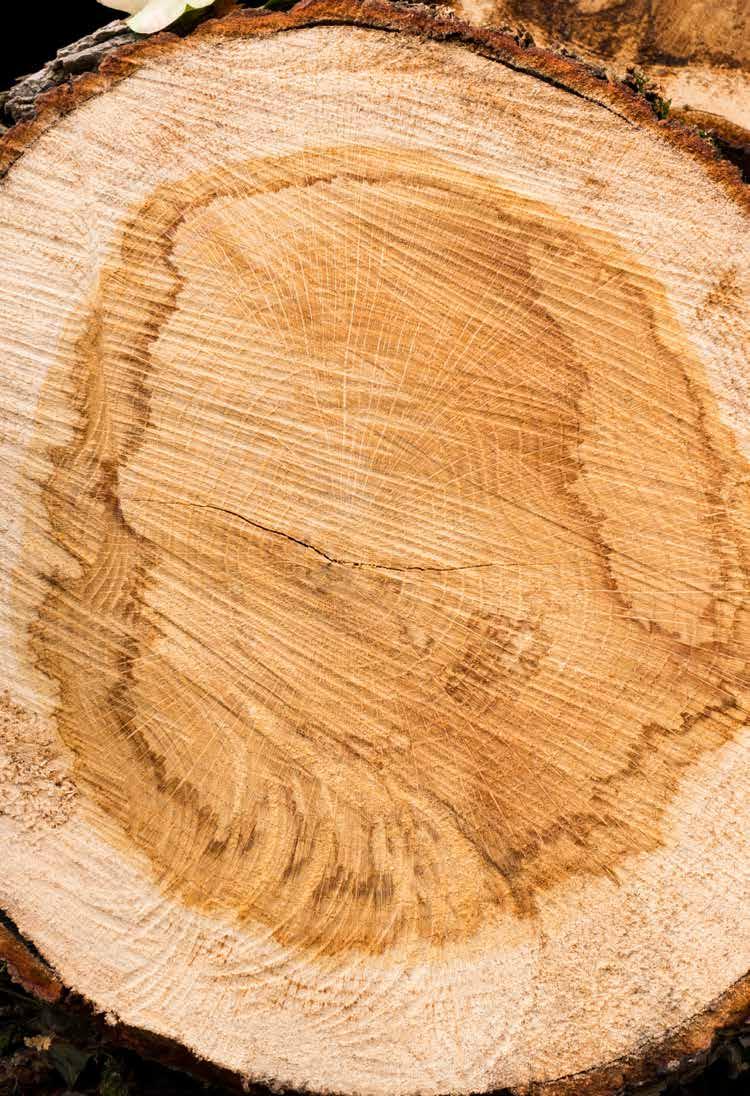
“The creation of a thousand forests is in the acorn.”
Ralph Waldo Emerson
Forestry is one of the most exciting and diverse sectors to work in. It is incredibly important to our economy, environment and to our communities. Hence this induction pack – created to support you and make sure you have the key information ‘in one place’ as you start your journey into the modern world of trees and timber.
In 2021, forest and woodland cover in the UK was estimated to be 3.23 million hectares, equivalent to nearly 8 million football pitches. This represents 13% of the total land area of the UK, 10% in England, 15% in Wales, 19% in Scotland and 9% in Northern Ireland. Although our percentage of forest and woodland cover is increasing, the UK is still well below the European Union average of 38%.
The term ‘forestry’ is often thought to simply mean the growing of productive forests for timber: from planting seeds to forest management; harvesting and haulage through to timber processing (e.g. sawmills and wood recycling). But in reality it means so much more. Woodlands combat flooding, provide habitats for protected species, create vital green space near where we live and work, and mitigate against climate change – maybe the biggest challenge of our lifetime.
This naturally low-carbon sector plays an important role in the construction, renewable energy and tourism sectors. Increasing our use of sustainable, environmentally friendly materials, like timber, has the potential to make an even greater contribution and impact in many areas of society.
Forestry will play a big part helping to mitigate climate change, by locking carbon up in growing trees, whilst at the same time providing habitats for flora and fauna and supporting biodiversity. More woodlands will also provide us with places to walk and cycle, which help us to stay healthy and connect with nature. Forests also produce a sustainable, renewable, biodegradable product – wood! While it can be turned into lots of things already, like paper, card, plastic alternatives and even to replace steel in building, it also has a low carbon footprint. Our growing awareness of what’s best for our planet means that the use of wood and the products it’s made from can only increase.
Forestry contributes 19.3 billion to the UK economy and employs around 560,000 workers. As such, it makes a significant contribution to the UK’s economy, environment, and culture. However, what we need from forests and how we design and plant them might well be different in future, and so the sector needs talented, smart and enthusiastic people to design the landscapes of tomorrow. New technologies will also allow us to plan and monitor smartly over a bigger scale than ever before.
The pack is divided into two parts: The Trees (the science) and The Wood (the practical manual). By its very nature the first part is fascinating. The information in the second part is crucial to ensuring your competence on the job and the safety of yourself and others. Throughout, we have taken guidance to ensure it is as up to date as possible, but time moves on, so please do also follow the links and check ‘at source’.
For the first part you might want to put the kettle on and settle down to a good read or even take a thermos out into the woods as long as it’s not blowing a gale. For the second part you might want to take it a bit at a time, a spot of bedtime reading perhaps (always good for memorising) along with a cup of cocoa.
But most importantly, I hope this guide helps support your first steps into a happy future in forestry.
For this second edition we have added a third part, interleaved between the two mentioned above: Why Forestry is Important.
Liz Dr Liz Barron-Majerik, MBE MICFor Chair of the Forestry Skills Forum“Every tree is a soldier in the fight against climate change.”
“The forest and timber industry spans the complete lifecycle of wood.”
We depend on forests for our survival. Forests regulate ecosystems, protect biodiversity, play an integral part in the carbon cycle, support livelihoods, and supply goods and services that can drive sustainable growth. Many of the goods we use come from forests directly or indirectly. Although we tend to associate forestry mainly with the timber used for construction and furniture, as well as wood fuel, Non-Timber Forest Products (NTFPs), such as medicines, resins and bamboos are increasing in value and importance, as is their importance in health and wellbeing and of course in mitigating climate change.
We use products from trees every day, from the obvious wood and paper, to the chemicals extracted from trees, which are used to make thousands of products. All parts of the log are used, so there is virtually no waste, and leftover sawdust is used for energy to run the mills.
• There are so many examples of products made from wood: houses, furniture, toothpicks, baseball bats, musical instruments, charcoal, fences, floors, bridges and much more.
• Wood pulp is used to make all paper products, including books, packaging material, cardboard boxes, coffee filters, tissues, blankets, building insulation, and more.
• Natural dyes, oils, tar, pitch, menthol and turpentine are chemicals made from trees. Chemicals extracted from trees also are used in the manufacture of cleaning products, deodorants and cosmetics. For example, sodium lauryl sulphate is a papermaking by-product used in shampoos and shaving creams as a foaming agent. Drugs made from trees include Taxol for cancer, Aldoril for hypertension, L-Dopa for Parkinson’s disease and quinine for malaria.
• Cellulose fibres from trees are used to make clothing, cellophane, adhesives, food additives and thickeners, helmets, twine, luggage, sandwich bags, cigarette filters and photographic film.
• Some examples of foods that come from trees are almonds, apples, bay leaves, cherries, hazelnuts, juniper berries (used as gin flavouring), pine nuts, plums and walnuts.
Forests are a great place to improve physical and mental health, seek adventure, make memories and find escape. They are host to a wide range of activities that demand a range of fitness and motor skills, such as trail running, mountain biking, pony trekking and even sled dog training.
• There were an estimated 446 million visits to woodland in England in 2015-16.
• There were an estimated 90 million visits to woodland in Scotland in 2013.
• There were an estimated 68 million visits to woodland by Welsh residents in 2014 https://www.forestresearch.gov.uk/ publications/health-and-well-being/
Wales offers a number of forestry-related recreational opportunities, and Natural Resources Wales provide detailed walking and hiking maps for public use. Welsh forests have previously hosted the World Rally Championship, which is the largest and most high-profile motor rally in the United Kingdom!
For those seeking a more relaxing experience, forests can be used for bird watching and photography, or just relaxing under the canopy, enjoying the unique sights, sounds and smells of the forest. The Japanese practice of Forest Bathing, is a process of relaxation, known in Japan as shinrin yoku. The simple method of being calm and quiet amongst the trees, observing nature whilst breathing deeply can reduce stress and boost health and wellbeing in a natural way. https://www. forestryengland.uk/blog/forest-bathing
Visiting forest environments can help lower blood pressure and pulse rate, reduce cortisol levels and suppress sympathetic nervous activity.
The longevity of trees and forests means they often carry an emotional connection for people, inspire awe, and connect people with places and memories. They also provide artistic/creative inspiration for many. Grizedale Sculpture Park in Cumbria and The Forest of Dean Sculpture Trail in Gloucestershire are famous examples of where you can experience art in woodland settings. There are a number of prominent contemporary artists who work in wood including Andy Goldsworthy, based in Scotland, and David Nash, based in Wales. The increasing popularity of nature writing shows an appetite for a deeper engagement with our landscape and natural environment.
You can find out more about how to connect with nature here: https://www.forestryengland.uk/blog/howto-tune-into-nature or download the Forestry England ‘Forests for Wellbeing’ booklet here: https://www.forestryengland.uk/resource/ wellbeing-booklet
Flood risk is a major issue in the UK, and the increase in winter rainfall and extreme weather events caused by climate change are increasing the likelihood of such events. In addition to the potential advantages of flood control and storage, forestry offers a wide range of other benefits, including improvements to water quality, nature conservation, fisheries, recreation, and landscape.
Forests are known to help reduce flooding. They use more water than other vegetation types and can also affect floods through their soils holding back and delaying the passage of rainwater to streams and rivers.
You can find out more about forestry and flooding here: https://www.confor.org.uk/media/246067/ confor-37_forestryandfloodingreportfeb2016. pdf in Confor’s Forests and Flooding report.

Forests are a vital part of the carbon cycle, acting as both carbon sources (producing) and carbon sinks (storing). A forest is a carbon sink if it absorbs more carbon from the atmosphere than it releases. Carbon dioxide is taken in from the atmosphere and used to produce sugars, with the oxygen released back into the atmosphere. It is then stored in the tree – for example in the trunk, branches, roots and leaves, then in the litter and dead wood and in soils. A forest is a carbon source if it releases more carbon than it absorbs. Forest carbon is released when trees burn or when they decay after dying (for example through fire, age or disease). The net balance of all of these carbon exchanges determines whether a forest is a carbon source or sink, and how much carbon dioxide is released to the atmosphere overall.
The diagram showing the carbon cycle is adapted from Figure 3 of Broadmeadow and Matthews (2003). https://www.forestresearch.gov.uk/tools-andresources/statistics/forestry-statistics/forestrystatistics-2018/uk-forests-and-climate-change/ carbon-cycle/
Forests have moderated climate change by absorbing about one-quarter of the carbon emitted by activities such as the burning of fossil fuels. This reduces the rate at which carbon accumulates in the atmosphere and ‘slows down’ climate change. How well forests continue to do this, will as a result, affect the future rate and impact of climate change.
Trees and wood also appeal at a deep emotional and spiritual level with many people. The Tree of Life is a referred to in many of the world’s religions, mythologies and philosophical traditions. Wood is one of the five Chinese elements, the one that seeks ways to grow and expand. Wood heralds the beginning of life, springtime and buds and fertility. It’s a constant companion in our everyday lives, from musical instruments to log fires, tongue and groove panelling to cricket bats. Its uses are extensive, and often surprising, as you’ll have read above. It both supports us and pleases us time and time again. So, the importance of wood is not just aligned to our survival but also to the quality of our lives. There’s an ancient connection between trees and people, enshrined in the heart and soul of many cultures.


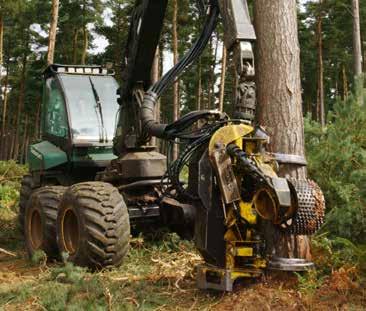
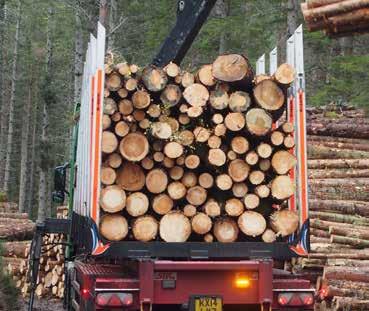
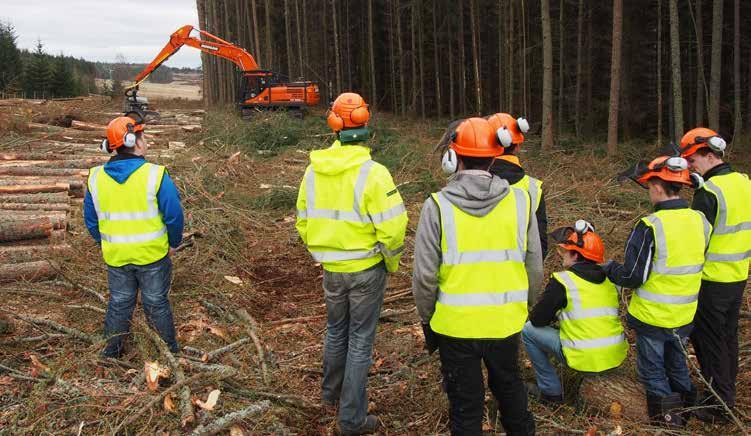
“Trees bring many benefits. Well-managed woods can help to combat the climate crisis by sequestering carbon and address biodiversity declines by providing havens for nature. Trees also clean our urban air, help alleviate flooding, prevent soil erosion… there is more to trees than timber!.”
why do forests matter? “
Forestry is a very broad sector, and if you haven’t worked with trees before, it can be hard to know where to start.
It is the science and craft of creating, managing, using, conserving, and repairing forests and woodlands. We manage the forestry resources for human and environmental benefits, whether they be in the form of plantations or ancient woodlands.
It is a diverse industry with many different roles requiring different skill sets and knowledge. Subject qualifications useful when working in forestry include:
Business Management Chemistry
Computer Science
Design and Manufacture
Engineering English Environmental Science Geography Mathematics
Forestry and timber industry is so much more than lumberjacks cutting down trees. (though we need them too!). Many foresters work in our cities as urban or community foresters and an increasing number of forestry professionals work in biodiversity, conservation and landscape. The following types of role are just a few examples of those within the sector.
• Arboriculturalists
• Architectural technologist
• CAD technician
• Chainsaw operator
• Consultants
Contractors – establishment / fencing / harvesting
Engineer – chemical / civil / maintenance / mechanical
Data scientist - statistician
• Forest ecologist

• Forest ranger – conservation / education / recreation / wildlife
• Forest surveyor
• Forest worker / craftsperson
• Forester – community / harvesting / recreation & tourism / social
• Forestry consultant
• Forestry investor
• Forestry supervisor / squad leader
• GIS technician
• Hauliers
Land agent
Landscape architects
Machine operator
• Manager – contracts / forestry / harvesting / logistics / nursery / production / operations /sales / sawmill / woodland
Nursery growers
Policy advisor
Product technician
Recreation and community specialists
Sawmill operative
Scientists – geneticists
Tree breeders / pathologists / materials
Silviculturists
Squad leaders
Supervisors
Surveyors
Timber buyers
Timber haulier
Wood worker
Woodland investment advisor
Woodland / forest Officer
Yardsperson
“Forestry is really diverse: some jobs are very practical, others scientific; some work outside, others are more office-based utilising maps and databases; some involve communicating and engaging with people. We need all kinds of people and skills to help our sector to thrive!”
What is ‘Forestry’?
“The true meaning of life is to plant trees under whose shade you do not expect to sit.”
Nelson Mandela Biology
what skills do I need for a career in forestry?”
Trees are grown in nurseries before they are planted as part of a new, well-designed woodland. These can be native and non-native species depending on the objectives for the woodland and type of forestry management practised (see below). It typically takes between one and three years to prepare trees for planting.
One of the largest Forest Nurseries in Wales is Maelor Forest Nurseries. It is part of the BSW Group and produces an extensive range of commercial forestry and native broadleaf species, marketing approximately 35 million trees a year to customers throughout the UK and Europe.
Natural forest regeneration cannot always happen for lots of reasons such as grazing from sheep and deer or a lack of a natural seed source. Most of our woodland needs to be planted to help us reach our target, and this involves a lot of planning, from securing the land, designing the woodland, talking to the local community and other stakeholders, to preparing the ground, fencing the site before physically planting the trees themselves.
There is a range of support available to encourage planting and you can find out more here:
Scotland: https://forestry.gov.scot/supportregulations/farm-woodlands/planning-treeplanting
England: https://www.gov.uk/guidance/treeplanting-and-woodland-creation-overview
Wales: https://naturalresources.wales/ guidance-and-advice/business-sectors/forestry/ woodland-creation/?lang=en
Once trees are planted, they need to be established and managed for their agreed objectives. This could be for timber, landscape,
habitat, recreation, flood prevention or all of these and more. Nurturing and monitoring (both physically and remotely -for example through drones, lidar and satellites) takes decades of planning, dedication and hard work, and which must be carried out sustainably to the UK Forest Standard (https://assets.publishing.service. gov.uk/government/uploads/system/uploads/ attachment_data/file/687147/The_UK_Forestry_ Standard.pdf). There are a number of companies that operate in this area, who providing support services such as forest certification, digital mapping and woodland insurance. The UK Woodland Assurance Standard (UKWAS) is an independent certification standard for verifying sustainable woodland management in the UKhttp://ukwas.org.uk/
English forests range from vast medieval hunting grounds such as the New Forest or the Forest of Dean to small community woodlands providing vital green space so we can breathe and relax. Alongside their benefits for leisure, recreation and wildlife, our woodlands are a vital part of creating a sustainable economy, with timber used in creating everything from large scale building products down to bespoke hand crafted items.
Forests in Scotland can be large and mainly designed to provide timber, or small and close to communities, mainly providing biodiversity and landscape benefits; or within our cities providing vital green space. Of course big woodlands also provide these benefits and small woodlands can provide valuable timber. That’s the wonderful thing about trees.
The National Forest for Wales is a unique venture to establish a nationwide network of publically accessible woodlands and forests. It will stretch the length and breadth of Wales, making it accessible to everyone. https://www.youtube.com/ watch?v=UGhNsU7-I00
What is ‘Forestry’? (continued)
But for ease, we can break forestry down into smaller ‘subsectors’.
Agroforestry has been around for thousands of years, and refers to the planting of trees or shrubs amongst crops or grazing fields to provide shelter for livestock and crops, while also benefitting the environment.
Trees also produce a wide range of useful and marketable products from fruits/nuts, medicines, wood products, etc. This intentional combination of agriculture and forestry has a wide range of benefits, including improved yields from food crops, income generation, increased biodiversity, improved soil structure and health, reduced erosion, and carbon capture.
The Agroforestry Research Trust is a non-profit making charity, registered in England, which researches and educates about agroforestry and perennial crops. It undertakes research, runs courses, publishes guides, and sells plants, seeds and books. There is more Information here:
The Agroforestry Research Trust/Forest/ Gardening/Fruit Trees/Nut Trees/Perennial/ Vegetables
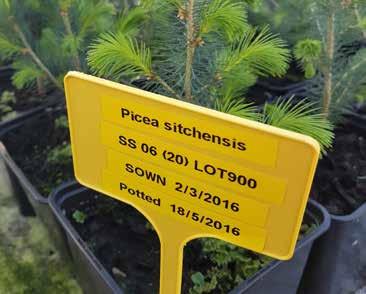
The Soil Association also undertakes work in this area: Agroforestry/Soil Association
And the link below shows a really great example of Agroforestry in Wales. https://www.youtube.com/ watch?v=UNU7ZEpOK_k
This is the care and management of single trees and tree populations in urban settings to improve our urban environment. It involves all the planning and management described above and is practiced by urban and utility foresters, environmental policymakers, city planners, consultants, educators, researchers and community groups.
Conservation forestry is an area of forestry that is focused on conserving and protecting forests. Conservation foresters can work for government agencies, non-profit forest protection groups, environmental advisory committees, private companies, or families interested in engaging in conservation activity on private land. Many colleges and universities with forestry programmes offer conservation forestry training to students who are interested in this specialty, along with research opportunities for people who are interested in the academic site of forestry.
An important part of conservation involves seed banks, places where seeds are stored to preserve diversity (genetic and ecological) for the future. Globally, it’s estimated that 40% of plant species are vulnerable to extinction, so it’s important that we have a way to help prevent this happening. There are over a thousand seed banks around the world, varying in type, size and focus. They are usually large vaults, which have to be flood, bomb and radiation-proof, in which seeds from different plant species are stored. The seeds are typically kept at low humidity and in cold conditions - around -20°C. This helps to preserve the seeds, ensuring they can still grow when they are needed later. In theory, seeds stored in these vaults can remain viable for potentially thousands (certainly hundreds) of years, depending on the species. It’s also common for each bank to send out a proportion of its valuable seeds to another bank as additional insurance.
The largest seed bank in the world is the Millennium Seed Bank in Sussex, managed and coordinated by the Royal Botanic Gardens, Kew. It opened in 2000 and holds seeds from almost 40,000 species around the world, including nearly all the UK’s native trees and plants.
The following sections explain the work involved in the timber side of forestry:
Technology is making the process of harvesting timber safer and more efficient. The modern day lumber jack or jill sits in a protected cab and uses a high-tech control panel to manoeuvre the blades that cut the wood. They keep in touch with the sawmill who tell them what kind of wood to cut and how much is needed.
Forestry is often an attractive asset for investors, as it provides the opportunity to benefit from the value of a naturally growing commodity and the security of ownership of the underlying land.
Owning a forest provides investors with an asset that has benefits for air quality, climate change mitigation, biodiversity, soil conservation and flood prevention. It is, of course, a long-term investment!
Hauliers play a vital role in our modern forestry supply chain. They move millions of tonnes of logs from the forest to timber processors, often along remote, rural roads. Some timber is moved by sea and rail. Once processed, the timber products are then transported to suppliers for onward distribution.
“The processing of the wood from our forests into sawn timber and panel products takes place in sawmills. These range in size from small one- person operations to large high-tech sawmills with systems, which scan 3D logs to optimise cuts. Whether the product is board, construction timber, fencing or pallets the processing is extremely efficient and nothing is wasted. A range of secondary processors create products from furniture to pre-manufactured buildings.”
The wood that we harvest from our forests is of exceptional quality. It’s not only a beautiful material to work with, whether you are an architect, designer, construction engineer or furniture maker, it is also a reliable and sustainable one – using much less energy than other materials.
Wood can also be burnt to release renewable energy. Renewable energy from biomass boilers can power farms, homes and businesses. Woodfuel, in the form of logs or woodchip pellets, can also be used in wood-burning stoves to warm up our homes and heat our water.
Coppicing is a technique that can be dated back to the Stone Age, and involves repeatedly felling trees at the base (or stool) and allowing them to regrow. This practice has a number of benefits over replanting, as the felled trees already have developed root systems, making regrowth quicker and less susceptible to browsing animals and shading from plants above which could limit growth. The demand for coppice timber is low as it is only small in size, but it remains a popular conservation practice for the benefits it offers to wildlife and to the trees themselves. Trees naturally retrench (shedding their branches to extend their lifespan) and coppicing can simulate this to increase the life of the tree. It also increases biodiversity, as greater amounts of light can reach the ground, allowing other species to grow there, which are often food sources for butterflies and other insects, which in turn provide food for birds, bats and mammals.
Trees have the power to transform places and strengthen communities, in some cases to the extent that the community takes ownership of their local woodland. A community woodland is one partly or completely controlled by the local community, through a community woodland group. The woodland may be owned or leased by the group, or managed in partnership with
a public or private sector landowner. They are extremely diverse, embracing all woodland types from ancient semi-natural woods to extensive conifer plantations, and ranging from less than a hectare to over a thousand hectares in size. The UK has a great tradition and knowledge of community forestry with communities ranging from crofting townships in the far north and west to small towns and inner-city communities.
You can find out more about Community Forests in Scotland here: https://www.communitywoods.org/

Find out more about England’s Community Forests here: https://englandscommunityforests.org.uk/
And about community woodlands in Wales here: https://llaisygoedwig.org.uk/
The Forestry STEM Ambassador scheme also helps to support community and school engagement. An increasing network of foresters have signed up to the scheme, which helps us to promote the diversity of roles within forestry, what we do and the importance of forestry to the country and community. You can find out more about the Forestry STEM Ambassador Scheme here: https://www.stemambassadors.scot/forestrystem-ambassador-scheme
Social Forestry involves health and well-being activities run in a woodland setting. These can include woodland management tasks or woodland craft activities. The aim of these programmes is to build confidence in the participants, their self-esteem, and increase social interaction. Social Forestry is sometimes prescribed to an individual by their GP, which is also known as Social Prescribing. A major part of social forestry is an understanding of the physical, emotional and psychological benefits that woodlands have for people. Social Foresters may work with individuals or groups on woodland activities that are educational or therapeutic.
Social forestry can also be of benefit to the woodland itself as when communities engage with a local woodland it gives them a stake in its future. This means that it is more likely to be shown care and respect by visitors. Having a community that knows and loves a woodland may also be important when it comes to decisions on development.
Social Forestry programmes are run in England (by Small Woods) and Wales (by Coed Lleol (Small Woods Wales))
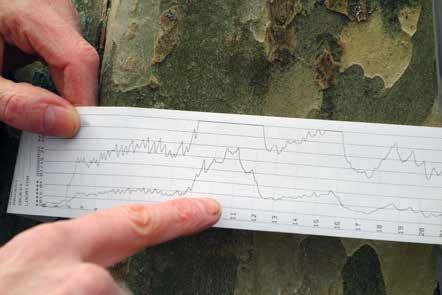


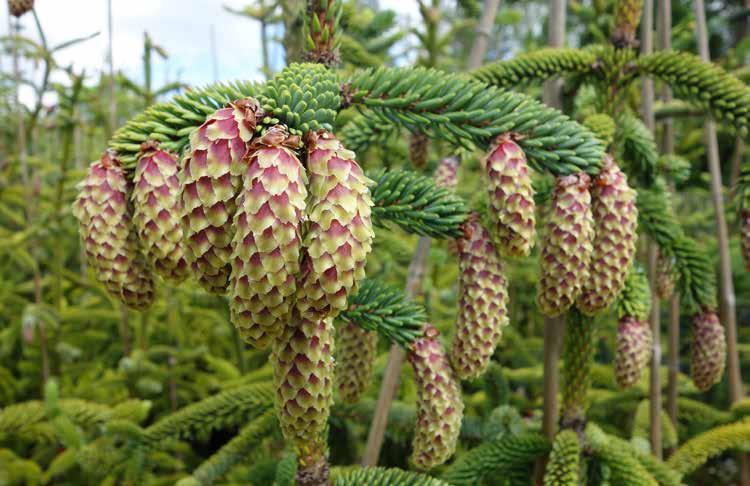
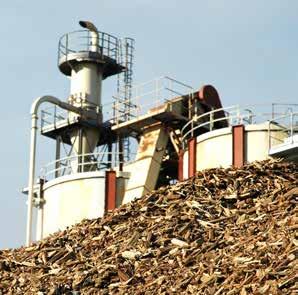
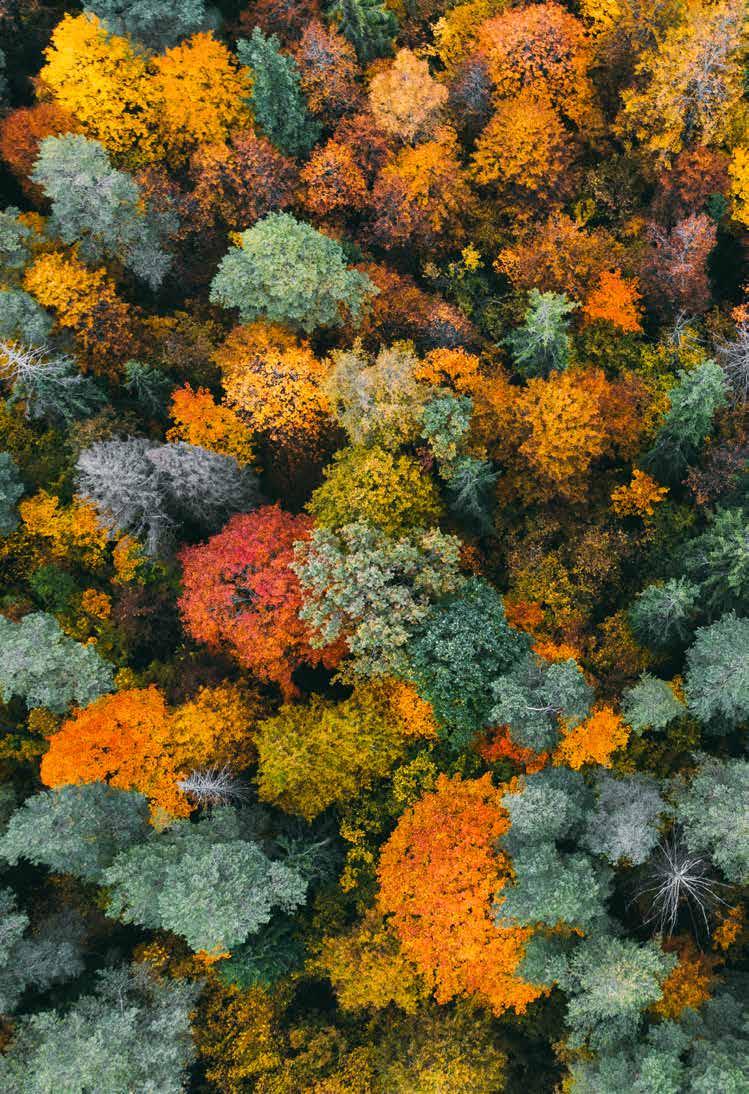
“For in the true nature of things, if we rightly consider, every green tree is far more glorious than if it were made of gold and silver.”
There is no standard way to describe a tree, but a useful one is to call it a plant with branches supported by a single woody trunk, which is different to a shrub, which has several narrow stems.
They come in all shapes and sizes; from tiny arctic willows a few centimetres high through to giant redwoods over 100 metres tall. Trees are the tallest free-standing organisms in the world and live longer and grow larger than any other living thing on earth.
There are more than 80,000 species of tree on our planet, which can be found in many plant families. There are two main groups; gymnosperms and angiosperms.
• Gymnosperm means ‘naked seed’. They do not produce flowers and have seeds, which are pollinated (fertilised) by the wind rather than insects. Pine cones are an example. Many are conifers, such as Yew and Scots pine.
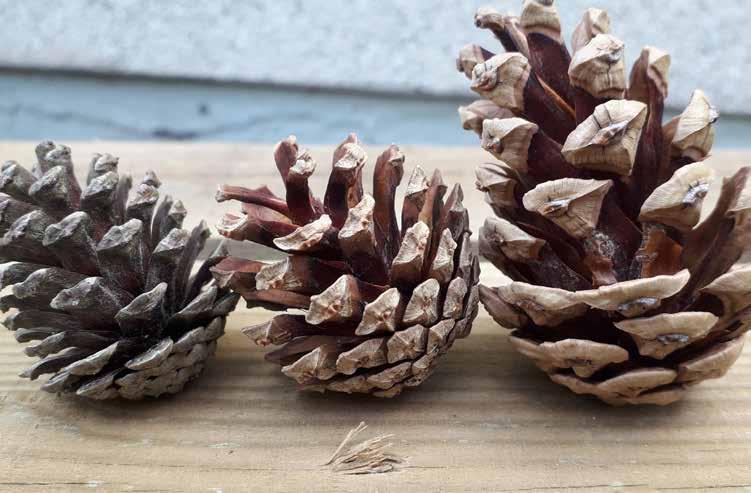

Pine cones – Left to right: Lodgepole, Scots, Corsican
“Don’t panic! Focus on the main species described in this chapter. As you find out more about each one, they will become easier to identify.”
“Smithy, how on earth am I going to remember all these different types of tree?”
• Angiosperm means ‘hidden seed’. These normally have flowers and seeds hidden inside a fruit often pollinated by insects, birds and mammals. The angiosperms can be thought of as hardwoods, such as oak and beech.
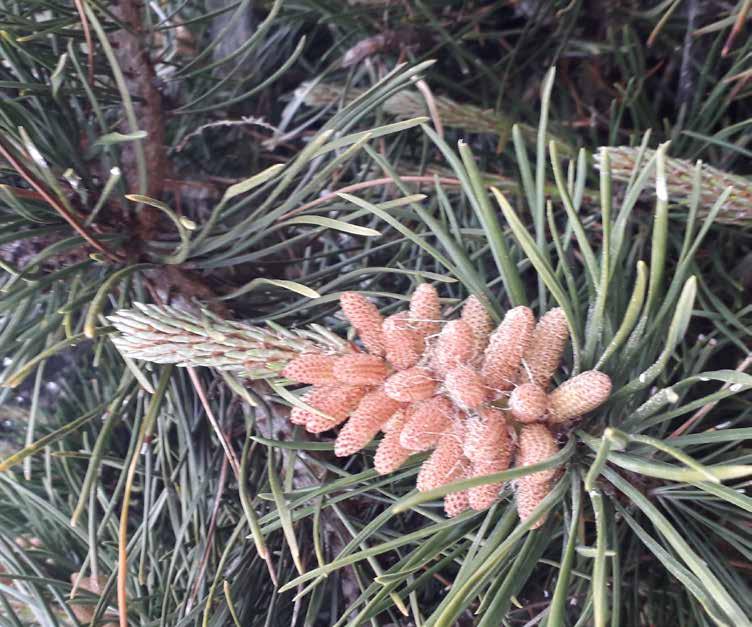
However, when categorising trees, it is important to be aware that there are usually exceptions to the rule. Even within the strict biological classifications described above there are variations. For example, some angiosperms — like the elm — make use of wind pollination.
If you were to categorise trees into needle trees and broadleaf trees, then there are exceptions
here too. For example ginkgo is a conifer (gymnosperm) but it has flat broad leaves.
Finally, we could just call them evergreen or deciduous, with evergreens keeping their leaves and deciduous trees shedding theirs at the end of the growing season. It is easy to assume that trees with needles are evergreen and broadleaved trees are deciduous. However, Larch is a needle tree (gymnosperm), which loses its leaves in winter and Holly is a broadleaved tree (angiosperm), which keeps its leaves all year round.
Classifying
The UK has at least fifty species of native trees and shrubs, and many more species of non-native trees that have been introduced.
Working out which is which can seem a bit daunting at first, but there are lots of features that help you to work out what species it is.
The leaves or needles will tell you whether it is a broadleaf (usually deciduous) or a conifer (usually with needles or scales). Different features will be visible through the seasons though, so for example for broadleaf trees in winter, you will have to use twigs, leaf buds and bark for identification.
The surrounding area will also give you clues as some species are more likely to grow near water, in scrubland, parkland or in woodland. Then put the clues together, including the overall shape and size of the tree, bark, leaves or needles, flowers, fruits, leaf buds and twigs. The more features you can see, the more accurate your identification will be.
• Size and shape: some trees are typically short and squat, others are tall and thin
• Leaves: the leaf shape, size and colour are important features
• Flowers, fruit or cones: though these are normally only found at certain times of the year
• Trunks: each has bark of a typical colour, pattern and texture.
• Winter twigs and buds: these are usually quite distinctive, their size, shape, colour and the layout of buds can be useful in identifying the species.
Bear in mind that individual trees are quite adaptable or ‘plastic’. You may find two trees of the same species that look quite different, often due to the environment surrounding the tree. For example, an oak that has grown on its own in a park may look quite different from one that has grown in-between other trees in denser woodland.
Even leaves can vary on the same tree. This is because a tree makes its leaves according to how much light is available and typically produces ‘sun leaves’ and ‘shade leaves’. The latter are normally found lower down and are larger and darker in colour – to absorb more light in the shade. Sun leaves are normally at the top of the tree and as they are more exposed to light they can be smaller in size and lighter in colour – better able to tolerate brighter light.
Trees come in many different forms and have different properties and uses – the following pages introduce you to the main kinds found in the UK.
See: https://forestryandland.gov.scot/learn/trees https://www.woodlandtrust.org.uk/treeswoods-and-wildlifeBritish-trees/a-z-of-britishtrees/
“The tree which moves some to tears of joy is in the eyes of others only a green thing that stands in the way. Some see nature all ridicule and deformity... and some scarce see nature at all. But to the eyes of the man of imagination, nature is imagination itself.” William Blake
Conifers normally have cones and needle-like leaves. They are usually evergreen and do well in colder conditions. Some, like larch, are deciduous and lose their needles in winter. They are fast-growing, thus make up the majority of the trees we grow for timber harvesting.


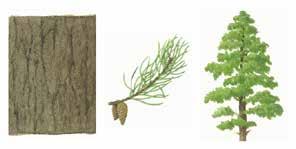
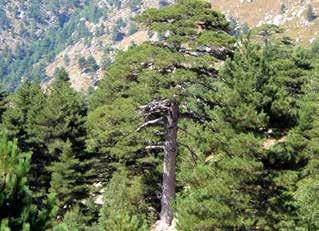
Pinus nigra subsp. laricio
Height: Up to 27 metres.
Lifespan: 500 years.
Leaves: The needles are long, grouped in pairs and have a distinctive twist.
Seeds: Its large shining cones are always one-sided or oblique.
Bark: Its fissured (cracked), dark greyish-brown bark breaks off easily.
Native to: Corsica, Sicily, and Calabria in Italy.
Uses: It was first introduced to the UK in 1759 and its timber was used for railway sleepers and pit props. Though not naturally durable, and considered inferior to Scots pine, it takes preservatives well and is used for general building work, telegraph poles and for processing into plywood.
Height: Up to 60 metres.
Lifespan: 500 years.
Leaves: It has soft needles with two grey bands on the underside.
Seeds: The oval-shaped cones hang downwards with a three-point bract - a special type of leaf — on every scale.
Bark: Reddish-brown, fissured and corky.
Native to: From British Columbia to California.
Uses: The Douglas fir is the major timber species in North America, and its timber is imported here as ‘Oregon pine’. Originally grown in this country for ornamental purposes, it is now used for sawmill timber and paper pulp. It is also important in construction, as high quality plywood and veneers, as well as for furniture and panelling.
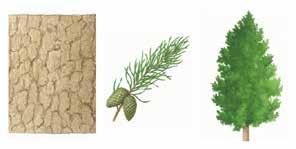
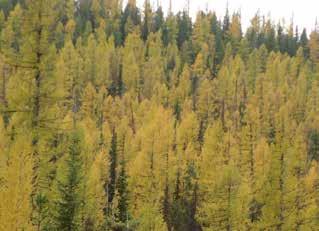
Height: Up to 40 metres.
Lifespan: 300 years.
Leaves: It grows deciduous needles in rosettes on short shoots.
Seeds: Reddish-purple female flowers form cylindrical cones with rounded scales, many of which turn outwards.
Bark: Grey-brown, fissured into regular plates.
Supports: 17 species of insects.
Native to: Central Europe and Japan.
Uses: Its strong durable timber is used for fencing, rails, cladding, construction and gates.
Height: Up to 50 metres. The tree tends to lose its lower branches as it matures to 24 metres in height.
Lifespan: 250-600 years.
Leaves: It has twisted yellowish-green needles found in pairs that are 5–8 centimetres long.
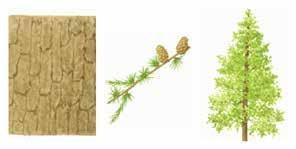
Seeds: It has cones with prickly scales that require high temperatures to open and release seeds.
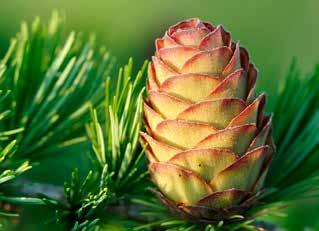
Bark: Variable but typically red-brown with fine curled flakes.
Native to: Pacific coast of America through to Alaska.
Uses: Its timber is used for roofing, flooring and other joinery. It is also used in the production of chipboard and paper pulp.
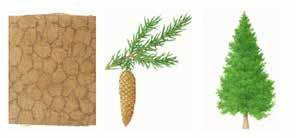

Height: Up to 45 metres.
Lifespan: 150-300 years.
Leaves: It has long upswept bluish-grey needles at right angles to the twig.
Seeds: Its seeds are large upright cones with downturned feathery bracts.
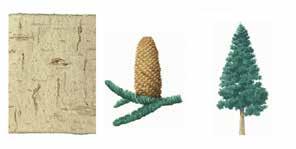
Bark: Pale grey to purplish, smooth.
Native to: Western North America.
Uses: The Noble fir has been planted on a very limited scale in wetter, western parts of the UK. Its timber is hard and close-grained and often used for interior joinery such as kitchen units.
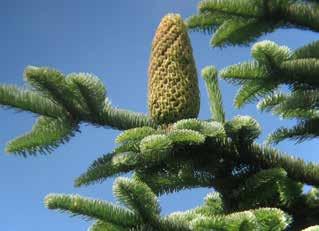
Height: Up to 40 metres.
Lifespan: 200 years.
Leaves: It has pointed mid-green needles standing on tiny pegs.
Seeds: It has long cylindrical brown cones which hang down.
Bark: Smooth, greyish-brown with a rusty tint.
Native to: Throughout Europe.
Uses: Its tough and elastic timber, known as ‘white deal’, is used for internal building work, boxes and paper. Its sound transmitting properties make it ideal for certain parts of violins and its timber is sometimes referred to as ‘violin wood’. In the past its twigs were used for making spruce beer and its resin was used as a source of turpentine and pitch (the sticky, resinous, black or dark brown substance left as a residue after the distillation of wood tar for turpentine).

Height: Up to 36 metres. It tends to lose its lower branches as it matures.
Lifespan: 300 years.
Leaves: Its twisted blue-green needles are found in pairs.
Seeds: It has brown egg-shaped cones, in clusters of two to four that point backwards along the stem, with a small sharp prickle on each scale. The Scots pine also has pointed hanging cones with woody scales.
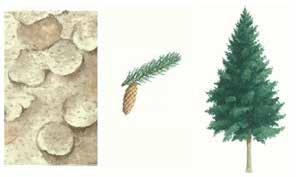
Bark: The upper bark is an orange-red, while the lower bark is deeply fissured.
Supports: 172 species of insect.
Native to: Northern Europe and Asia, Spain and Asia Minor.
Uses: In the past it was used for ships’ masts, as a source of turpentine, resin and tar, and for charcoal. Today Scots pine timber is used for building, furniture, chipboard, boxes, fences, pallets and packaging, telegraph poles and paper pulp.
Height: It tends to grow up to 55 metres but can reach 100 metres. It is the fifth largest conifer in the world.
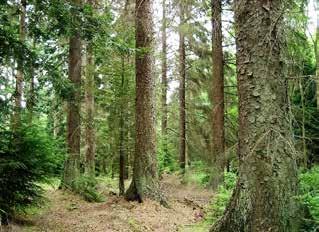

Lifespan: 600 years.
Leaves: Flattened solitary needles pegs have a slate blue tint and sharp points.
Seeds: Light brown cones have thin papery scales with crinkled edges.
Bark: Greyish-brown. When mature, flakes off in round scales.
Native to: West coast of North America, from Alaska to California.
Uses: This is a versatile timber, with smaller trees being of particular value for paper making due to their fibre length and white colour. It is also used in the manufacture of different types of board. Sawlog material is used for pallets and packing cases with the better grades used for building.
Height: Up to 50 metres. It loses its lower branches as it ages.
Lifespan: 500 years.
Leaves: It has random needles of varying lengths, with green above and white below.
Seeds: Numerous small egg-shaped cones.
Bark: Over time its bark becomes deeply furrowed into scaly ridges.
Natural range: Western North America, from Alaska to California.
Uses: The wood has the ability to hold nails well and is used for building, package boxes and paper pulp. In the past the Native Americans used the inner bark for bread making.
Other: It is not related to the highly toxic herb hemlock, but shares its name due to the similar smell.

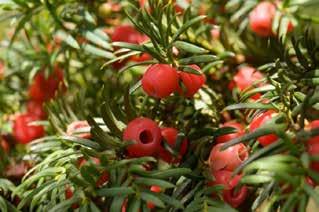

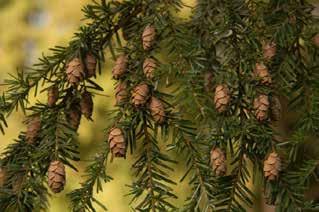
Height: 15-29 metres.
Lifespan: 5,000 years.
Flower: Male and female flowers are borne on separate trees, which is a primitive feature in conifers.
Seeds: When a bird eats one of the fruits it digests the fleshy jacket, or aril, and passes the poisonous seed intact.
Bark: Thin and scaly, becoming deeply furrowed and breaks away in long flakes.
Natural range: Europe, Atlas Mountains, Asia Minor to Persia.
Supports: 4 species of insect.
Uses: Although a ‘softwood’, it grows slowly, giving the wood great strength. Its thin, springy branches were once used for making longbows. Nowadays the wood is made into veneers and is used for furniture making. Yew is popular in gardens as it can withstand unlimited clipping and shaping and hence is often found in churchyards, parks and estates.
Other: Every part of the tree - except the fleshy seed cap - is poisonous to humans and cattle but not to deer or rabbits. “The Fortingall Yew, one of the oldest trees in the United Kingdom, if not in Europe, lives in a churchyard, west of Aberfeldy.
Broadleaved trees usually have wide leaves that are shed in the autumn, although some, like holly – are evergreen. Because many broadleaved species used for timber grow so slowly, timber from broadleaves is known as hardwood.

Height: Up to 40 metres.
Lifespan: 200 years.
Leaves: Its leaves are arranged in pairs.
Seeds: The single winged seeds, called ‘keys’, grow in bunches.
Bark: Smooth and greenish-grey, turning grey and fissuring with age.
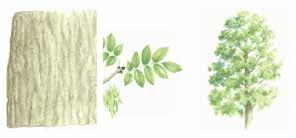
Supports: 41 species of insect and 255 species of lichen.
Native to: Europe, Asia Minor and North Africa.
Uses: Its wood is used to make handles for axes and spades, oars, flooring, hockey sticks and rackets. In the past, ash wood has been used for skis, coaches, carts and farm implements.
Height: Up to 40 metres.
Lifespan: 350 years.
Leaves: Green in spring and summer, turning first to yellow then to bronze in autumn.
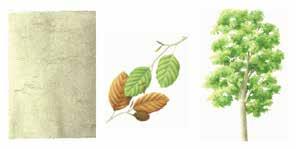
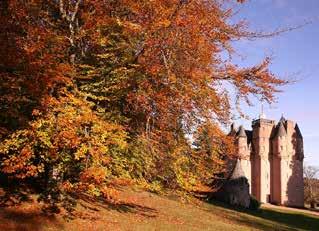
Seeds: The husks split to release two triangular seeds, ‘nuts’ or ‘mast’ which can be eaten. The French roast them to make a type of coffee.
Bark: Smooth, grey and delicate – making it a popular tree for lovers to carve their initials into.
Supports: 98 species of insects including mites and 206 species of lichen.
Native to: Europe, but not Scandinavia.
Uses: Beech wood is easily turned, fine-grained and knot-free, making it ideal for furniture.

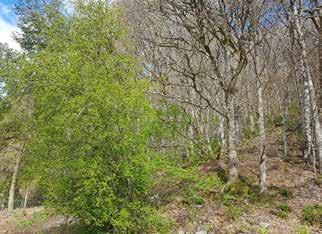

Height: 7 metres if left uncut (it resembles a shrub).
Lifespan: 70 years.
Flower: In late winter, male flowers form ‘lambs-tails’ catkins.
Fruit: In October, ripe nuts are enclosed in leafy bracts.
Bark: Smooth, shiny brown with conspicuous yellow lenticels and scaly patches.
Native to: Europe (but not the Shetlands) and Asia Minor.
Uses: In the past, hazel was used for firewood, ‘wattle and daub’ building, thatching spars, fences and garden plant supports. A small hazel coppice industry still thrives today. There is a type of Whitebeam Hazel that is only found in the Avon Gorge in Bristol and it is critically endangered.
Height: Up to 15 metres.
Lifespan: can live for 400 years, although 250 is more typical.
Flowers: Highly scented, white or occasionally pink with five petals, and grow in flat-topped clusters.
Fruit: Once pollinated by insects, the flowers develop into deep-red fruits known as ‘haws’.
Bark: grey with shallow, longitudinal fissures.
Native to: Hawthorn is native to the UK and has been historically used in hedgerows around farmers’ fields, although this is less common in Scotland.

Uses: Common hawthorn timber is pale creamy brown, fine grained and very hard. It can be used in fine work from turnery to engraving. It also makes excellent firewood and charcoal; with a reputation for burning at the highest temperature of any wood. In medieval times, the smell of hawthorn blossom was described as ‘like the smell of the Great Plague in London’, which is likely because the chemical trimethylamine present in hawthorn blossom is also formed in decaying animal tissue.
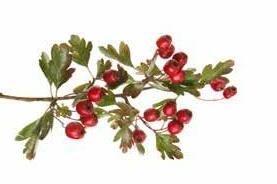
(The former, the Royal Oak, is England’s national tree and the latter, the Sessile Oak, is Wales’s national tree)
Height: Up to 30 metres.
Lifespan: 800 years.
Leaves: Rounded knobs - or lobes - extend round the whole leaf.
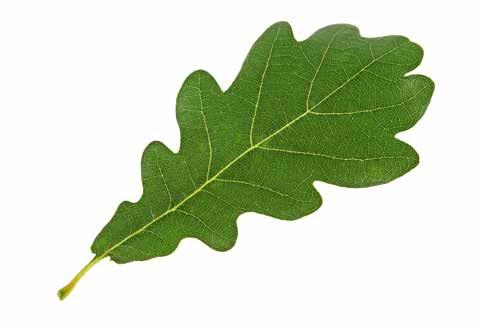
Seeds: Acorns are carried on long stalks or ‘peduncles’. Most oak trees do not produce acorns until they are over 50 years old.
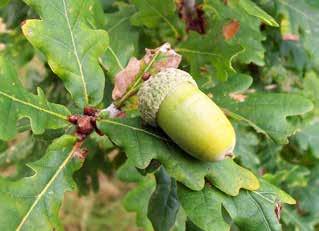
Flowers: The female flowers are on stalksa feature characteristic of the English oak that distinguishes it from the closely related sessile oak (Quercus petraea).
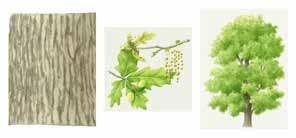
Bark: An oak tree’s bark becomes fissured with age.
Supports: 423 species of insect including mites and 324 species of lichen.
Native to: Europe and Asia Minor.
Uses: For centuries, its strong and durable timber has been used for shipbuilding and for making timber frames of buildings. The tannin in its bark was also used for tanning leather. Today, oak timber is used in construction as well as to make furniture and whisky barrels. The tree is also planted for its conservation value. King Charles II even hid in an Oak Tree to hide from Roundhead soldiers during the English Civil War in 1651. Wales has a long history of shipbuilding using strong and durable oak. In the 19th century lots of Welsh ports produced ships, most notably Pwllheli.
“When the oak is felled the whole forest echoes with its fall, but a hundred acorns are sown in silence by an unnoticed breeze.”
Thomas Carlyle
Height: Up to 15 metres.
Lifespan: 120 years.
Leaves: Between 11–15 toothed leaves cling to each branch head. These turn red during the autumn months.

Fruit: The bright red berries provide good autumn feeding for many birds, especially migrants from Scandinavia.
Flowers: The rowan has flat heads of cream coloured, heavily scented flowers.
Bark: Its bark is smooth and a purplish - or grey-brown.

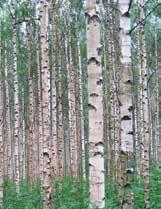
Native to: Northern Europe.
Uses: Its strong flexible wood was used for making tool handles and sometimes longbows. The wood is dense and used for carving tool handles and walking sticks. In Finland, it has been a traditional wood of choice for horse sled shafts. The rowan’s red berries have a high vitamin C content and were made into a drink to combat scurvy. They are still used today to make a jelly to accompany meats. The tree is found higher in the mountains than any of Scotland’s other native trees. Its botanical name
is Sorbus aucuparia and it’s often called the ‘mountain ash’ despite having no relation to the ash tree. In the past, rowan trees were planted outside houses and in churchyards to ward off witches.
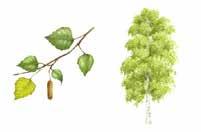
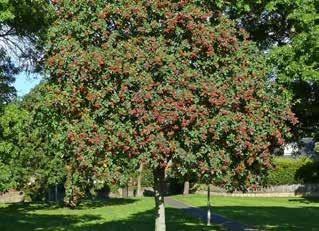
This tree has spreading lower branches with the rest pointing up.
Height: Up to 24 metres
Lifespan: 120 years
Leaves: Triangular leaves
Bark: Its silvery-white upper bark is papery and peeling.
Supports: 334 insect species (including mites) and 126 species of lichen.
Native to: Europe, North Africa and West Asia
Uses: Its pale, smooth timber is a hardwood and silver birch timber is often used in plywood production, veneers, the backs of brushes, toys and thread reels. On a lesser scale, the twigs are cut to make besom (witches) brooms and horse jumps.
“So, like a stand of birches, be briary, bend, touch earth, whip back to your high stance once again.”
Barbara Howes, A Stand of Birches


Height: Up to 35 metres.
Lifespan: 400 years.
Fruit: Unlike other limes, the fruits are neither ribbed nor hairy.
Bark: Its smooth, grey bark cracks with age.
Flowers: The sweet-smelling flowers attract bees, other insects and birds including woodpeckers.
Natural range: Northern Spain to the Caucasus and Siberia.
Uses: Its pale cream coloured wood is fine textured and resistant to splitting, making it ideal for carving. As it does not warp, lime wood is also used for the keys and sounding boards of pianos.
Height: Up to 40 metres.
Lifespan: 450 years (It broadens with age.)
Seeds: The husk splits to release up to three nuts in the autumn.
Bark: Its bark has distinctive long diagonal fissures.
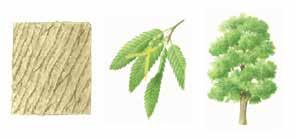

Flowers: Some catkins have male and female flowers on the same stalk. The remains of the male catkin stay attached to the husk until it falls off.
Natural range: Mediterranean and Asia Minor
Uses: The yellowish-brown timber is strong and good for cabinet making, coffin boards, construction and joinery and is often coppiced for fencing. It used to be used for pit props. In south-east of England it was widely planted for hop poles.
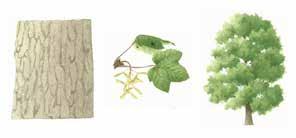
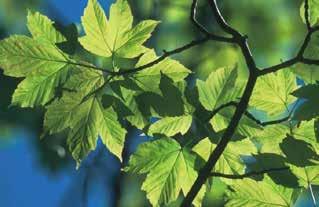
Height: Up to 25 metres.
Lifespan: 200 years.
Leaves: This is a broad tree with dense foliage. Its leaves often have “tar spots’” caused by the fungus Rhytisma acerinum.
Seeds: The sycamore seeds profusely and its winged seeds, set in pairs, usually fall together spinning round like helicopter blades.
Bark: The sycamore has smooth grey bark and develops rough flat surface plates that fall away to reveal orange-brown bark below.
Supports: 15 species of insect and 183 species of lichen.
Natural range: Central and southern Europe, north to Paris.
Uses: The pale cream timber is usually without a marked grain, making its finely grained pieces in high demand today for making violins and furniture veneers.
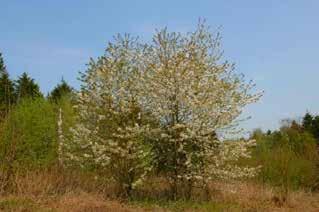
Height: Up to 24 metres.
Lifespan: 250 years.
Flowers: Its flowers can appear before the leaves and produce an almond-like scent.
Fruit: Scented white flowers are followed by small green cherries, which turn red then purple when ripe. Birds quickly strip the fruit and spread the seeds by dropping or swallowing them.
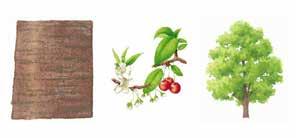
Bark: Smooth purplish-brown with metallic lustre and horizontal bands of lenticels.
Natural range: Europe, North Africa & West Asia.
Uses: The wild cherry is often used as rootstock for more productive fruit bearing varieties. Its wood is used to make fine furniture and musical instruments and is prized for turned items such as bowls.
“Just seeing trees from a window or walking past trees on our way to work restores our minds and bodies. That’s the magic of trees.”
Ancient trees are veteran trees, but not all veteran trees are old enough to be ancient.
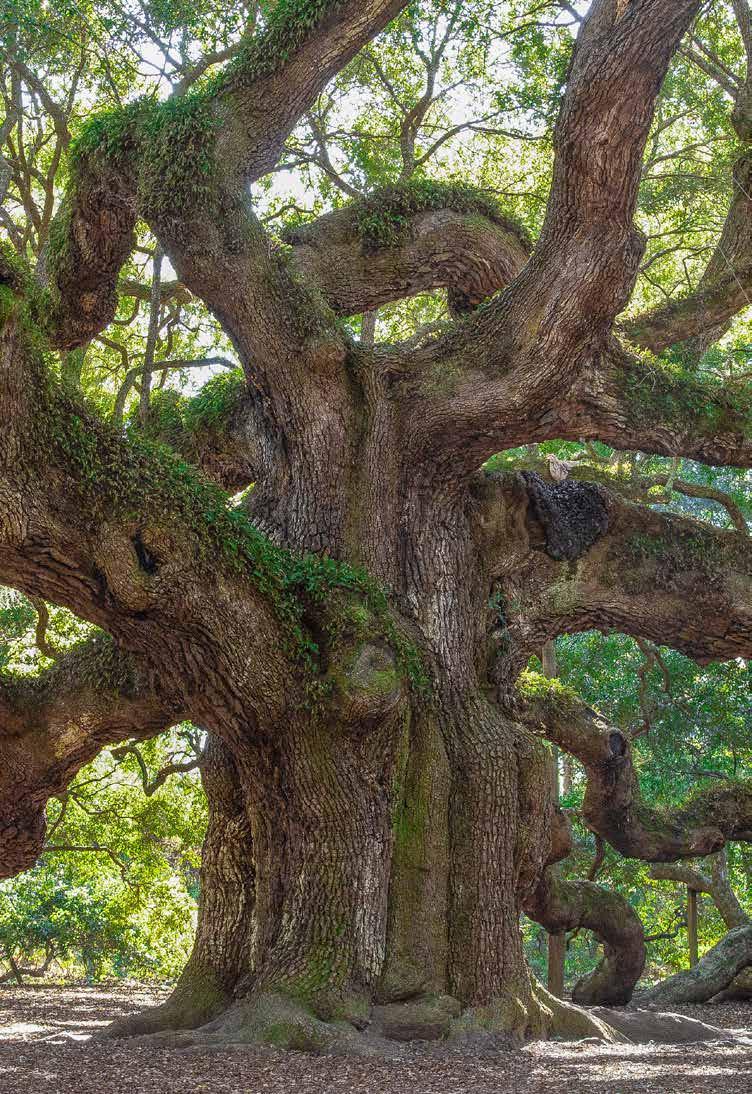
An ancient tree is one that has passed beyond maturity and is old, or aged, in comparison with other trees of the same species, but even in this stage the tree may stay alive and healthy for many decades. Dying ancient trees may endure for many decades, providing very valuable habitat for wildlife and an important connection for the community. Ancient Trees - Woodland Trust
Veteran trees are survivors that have developed some of the features found on ancient trees. However, veteran trees are usually only in their second or mature stage of life. Veteran trees may support a wide range of fauna and fugal bodies, many of which are only associated with long periods of continuity in their habitat. Britain has more veteran trees than most countries in Europe, and their conservation is of international interest.
There is more information on both here: (www.woodlandtrust.org.uk)
And here: https://coed.cymru/images/user/IAR%20Ancient%20Woodlands.pdf
Collecting and preserving plant specimens will give you information about plant diversity and distribution (i.e. what is where). A good plant collection is like a 3-D photograph, capturing information about a location and freezing it in time.

Plant specimens will rot unless they are preserved properly. They can be pickled, frozen or bottled, but the easiest and cheapest way to
preserve most plants is to press and dry them in a herbarium. This must be done well if plants are to be identified, stored, displayed or used for research, as if they are not completely dry they will decay and rot. And, of course, you will need to correctly name the plant.
Why not make a tree herbarium to help you identify the different species?
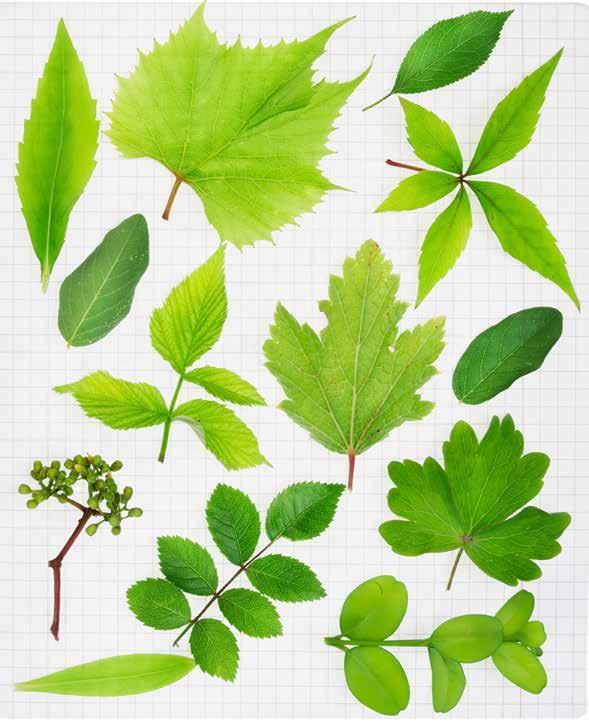
“Start easy, with distinctive leaves like oak and ash. Familiarise yourself with the trees that grow commonly in your local area through the seasons.”
“A herbarium is better than any illustration; every botanist should make one.” Carolus Linnaeus
Ask Jonesy!
“Jonesy… there are so many tree species, where do I start?”
The name for one type of tree can vary from country to country - even within the same country. So, in order to eliminate confusion, every animal or plant species has a double-barrelled, scientific or ‘binomial’ name. In the universal language of Latin. Latin names are conventionally written either in italics or underlined. One of the key aspects of binomials and classification is that they show us relationships between species and help us to predict what to expect from them. For instance other Picea species should have similarities with Picea abies.
• The first part, written with a capital letter, is the generic name, shared by all of the species belonging to the same genus or closely related group. This normally gives a clue to some general feature about that type of tree.
• The second part is the specific name or specific epithet and only refers to that one particular unique species. This may refer to the same distinct feature of the tree (colour, size) or where it comes from (habitat, country) or who discovered it.
This name remains the same for all countries of the world whatever their local name for that plant may be. So in the examples of tree species in this guide – the ‘easy’ name might vary from country to country but the Latin name would be the same.
For example – Picea abies is known as common Spruce, but here are some variations.
(Abbreviated to P.abies after the first mention.)
• English: European spruce; Norway spruce
• Spanish: abeto falso; picea commun; pinabete de Noruega
• French: épicéa commun
• Bulgaria: smurc
• Canada: épinette de Norvège
• Czech Republic: smrk
• Denmark: grau
• Finland: kinnsl
• France: épicéa
• Germany: europäische Fichte; Fichte; gemeine Fichte; Rottanne; Weissfichte
• Italy: abete rosso
• Netherlands: fijnspar; gewone spar; kerstspar
• Norway: gran
• Romania: molid
• Sweden: gran; vanlig gran
Within the members of any one species there are often small natural local variations in shape, size or colour, which are inherited genetic features and not just caused by the place or the conditions it grows under. Where these clear and genetically inherited differences occur in the wild, the trees are called varieties and a third Latin or scientific name is added on the end. For example, the Highland variety of Scots pine with its distinctive short, blue-green needles becomes Pinus sylvestris var. Scotica.
Where varieties naturally occur and are selectively bred for cultivation, the tree is called a cultivar. The cultivar’s name comes after the scientific names and in single quotation marks; for example there is a gold-leafed form of Scots pine that was raised in a nursery and is known as Pinus sylvestris ‘Aurea’.
When species of trees from the same genus but native to different parts of the world are brought together by human actions, any resultant hybrid will show the characteristics of both parents. One example occurred in Scotland, where European and Japanese larches were planted near each other and cross-fertilised produced the hybrid or “Dunkeld” larch. Its scientific name is written Larix x eurolepis. The x between the names indicates that both parents of this hybrid originate from the same genus.
“A rose by any other name would smell as sweet.” William Shakespeare
Woods themselves can also be categorised into five different main types:
Includes all upland (an area of high or hilly land) and upland fringe (on the edge) woodlands on reasonably well draining acidic soils, as well as woodland on very acid lowland heaths. Included are those in which Scots pine is abundant, often with birch and rowan.
https://forestry.gov.scot/woodland-grazingtoolbox/habitat-types/defining-habitat-types/ native-woodland/acidic-dry-woodland
Found in the uplands, upland fringes and lowlands with free-draining, brown earth soils that are either neutral or mildly acidic. Often dominated by oak or birch or a mix of the two species.
https://forestry.gov.scot/woodland-grazingtoolbox/habitat-types/defining-habitat-types/ native-woodland/neutral-dry-woodland
Occurs on base-rich soils in the uplands, upland fringes and lowlands. Ash and hazel are characteristic species. Oak and birch are commonly present.
https://forestry.gov.scot/woodland-grazingtoolbox/habitat-types/defining-habitat-types/ native-woodland/base-rich-dry-woodland
Occurs throughout Scotland, though most are found in the uplands and upland fringes, in areas of impeded drainage. It also occurs on wooded bogs in the lowlands. It is generally dominated by downy birch but some woods, especially in the west, may have thickets of eared or grey willows.
https://forestry.gov.scot/woodland-grazingtoolbox/habitat-types/defining-habitat-types/ native-woodland/acidic-wet-woodland
Occurs in the uplands, upland fringes and lowlands and includes lowland floodplain woodlands. Soils range from flushed mineral soils to very wet peats. The dominant tree species may be alder or eared or grey willow.
https://forestry.gov.scot/woodland-grazingtoolbox/habitat-types/defining-habitat-types/ native-woodland/neutral-to-base-rich-wetwoodland
Classifying sites can help forest managers to select the right tree species to plant, and to make the right ecological management decisions. As a result, classifications normally focus on the key factors of site that influence tree growth that are important to the rest of the ecosystem.
It is also important to know what other species might be present on a site, as this can help inform what tree species might perform there. This in turn can help you establish the National Vegetation Classification (NVC).

“Well, in forestry we are often dealing with huge areas of land, which could be used for a variety of purposes. Being able to easily define a site can help forest managers to select the right tree species to plant in the right place.”
“Smithy.... so why do I need to know all this?”
You may have a National Vegetation Classification (NVC) map of your site. For more information on NVC and other woodland classifications, see the National Vegetation Classification field guide to woodland. https://hub.jncc.gov.uk/ assets/673dc337-e58f-4f6b-ac7b717001983c2e
Since the 1980s when it was created, the NVC has become the standard classification used for describing vegetation in the UK.
There is a ‘kit’ to help you determine what kind of site a woodland area might be which is available here: https://www.forestresearch.gov.uk/ tools-and-resources/fthr/ecologicalsite-classification/
Recording Information on site
Choice of Location
Vegetation cover - percentage charts
Key to ferns and horsetails used in ESC
Key to sedges and allies used in ESC
Key to grasses used in ESC
Site Description Form
Key to Humus Form
Soil Assessment
Description of soil horizons
Colour Roots
Stoniness
Texture
Parent Material
Structure (not used in ESC)
Forest Soil Classification tables
Assessment of soil texture key
Soil Description Form
The Ecological Site Classification Decision Support System (ESC-DSS) is an online system designed to help forest managers and planners select ecologically suited species to sites, instead of selecting a species and trying to modify the site to suit.
Although it is quite complicated, essentially it is a tool that matches important information about a site with the requirements of the species living there. It also helps you work out the best tree species for that location. The evaluation is based on the match between key site factors and the ecological requirements of different species plus the ecology of woodland communities defined in the NVC. It also includes future climate change projections to allow you to incorporate future suitability into your planting decisions.
To help you identify what species might be present on a site, the library produced by the Royal Forestry Society includes many of the key species included in the ESC tool.
The list is laid out in alphabetical order according to the scientific name of each plant, though common names are also included and can be downloaded both individually and as a complete compilation booklet.
The Woodland Wildlife Toolkit is also a handy tool that provides advice on managing woodlands for wildlife, particularly rare or declining species that are dependent on woodland habitats.
Natural Resources Wales has also produced this resource which includes the latest information on tree species, provenance, seed and plant supply. It will help support deciding on which tree species to choose as well as help inform your future plant supply requirements.
We have described a few of the main species in our tree guide, but there are many more. You should think about buying the Collins Tree guide, although it is not always handy to carry around or refer to when starting out. Tree keys are handier as they tend to stick to a smaller number of species.
The Natural History Museum in London has produced a free to download Tree Key which uses colour photos
https://www.nhm.ac.uk/content/ dam/nhmwww/take-part/identifynature/tree-identification-key.pdf
The Forestry & Land Scotland website, Learn, Trees, has a guide with information on the Forest Cycle and working in the Forest. https://forestryandland.gov.scot/ learn
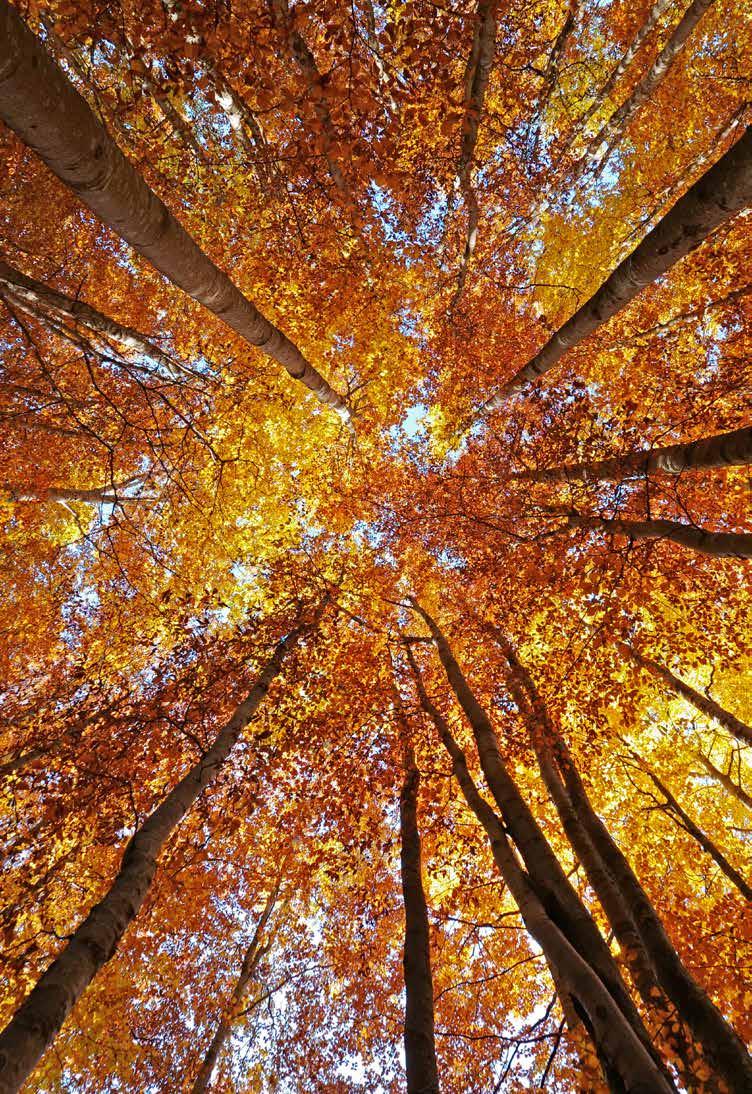
Woodland trust also has a good Tree ID app to use on phones
https://www.woodlandtrust.org. uk/trees-woods-and-wildlife/ british-trees/tree-id-app/
https://www.woodlandtrust.org. uk/trees-woods-and-wildlife/ british-trees/a-z-of-british-trees/
Trees are the tallest free-standing organisms in the world. They live longer and grow larger than any other living thing on earth. The world’s tallest known living tree at 115.7 metres is a Sequoia sempervirens, or coast redwood, discovered in the Redwood National Park in 2006. That’s almost 380 feet high, taller than Big Ben or the Statue of Liberty! The UKs tallest tree is an Abies Grandis or Grand Fir. It is over 60 metres tall and can be found in Ardkinglas Woodland Gardens, on the shores of Loch Fyne in Argyll, Scotland.
So how do they do it?
Inside a tree trunk there are several different layers of cells.
The first outer layer is the waterproof bark that protects the tree from the elements, from pests and fungal diseases and helps it to retain moisture. As the trunk grows, the bark spreads and cracks, creating fissures and giving the tree a gnarled appearance.
Underneath the bark there is a layer of tissue called the phloem (or bast), which transports the food (a sugary sap) made in the leaves during photosynthesis to all the other parts of the tree.
All plants grow from actively dividing cells called meristems found at the tips of buds and roots. In most woody plants there is also a layer of cells called the cambium, which sits underneath the phloem and is responsible for the outward growth of the tree. The cambium allows woody trees and shrubs to grow outwards as well as upwards in each growing season, allowing them to reach considerable sizes.
Next you will find several layers of woody tissue called xylem. These cells are wide with thin walls and help the tree transport large volumes of water from the roots to the trunk and branches to support the growth of new leaves and flowers.
The first few layers of xylem are known as sapwood. The xylem found right in the centre of the tree is known as heartwood. Heartwood is found in the centre of most trees, though not all. It can be a different colour, and can be naturally durable because of extra chemicals (extractives) that the tree put there (for example, tannins).
Notes on terms from www.britannica.com
Tree structure and growth. Land plants are descended from aquatic plants. The early aquatic plants required few modifications for structural support or water and nutrient absorption, since the surrounding water fulfilled their needs.
Once primitive plants began to invade the land, however, modifications for support, nutrient and water absorption, support, and reproduction were required. Because organic soils were not widely developed, the earliest terrestrial plants probably first colonized bare rock near large water sources, such as oceans and lakes.
Generations of these plants recycling nutrients (e.g., nitrogen, carbon, and oxygen) and energy into the stratum contributed to the development of a rich organic soil suitable for large shrubs and herbs. With the proliferation of these low-lying plants, competition for available space, nutrients, and sunlight intensified.
The colonization of aerial habitats and those farther afield from the large sources of water produced the physiological and morphological complexity found among the vascular plants.
“Trees are always a relief, after people.” David Mitchell (novelist)
“Never say there is nothing beautiful in the world anymore. There is always something to make you wonder in the shape of a tree, the trembling of a leaf.”
Albert Schweitzer

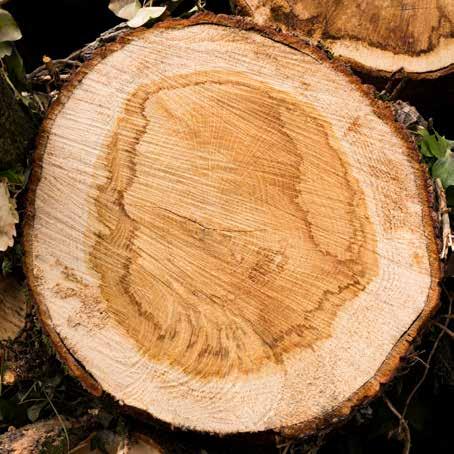
Bark, in woody plants, is the tissues external to the vascular cambium. The term bark is also employed more popularly to) refer to all tissues outside the wood. The inner soft bark, or bast, is produced by the vascular cambium; it consists of secondary phloem tissue whose innermost layer conveys food from the leaves to the rest of the plant. The outer bark, which is mostly dead tissue, is the product of the cork cambium (phellogen). The dead cork cells are lined with suberin, a fatty substance that makes them highly impermeable to gases and water. Gas exchange between the inner tissues of bark-covered roots and stems and their surroundings takes place through spongy areas (lenticels) in the cork.
Phloem, also called bast, refers to the tissues in plants that conduct foods made in the leaves to all other parts of the plant. Phloem is composed of various specialized cells called sieve tubes, companion cells, phloem fibres, and phloem parenchyma cells. Primary phloem is formed by the apical meristems (zones of new cell production) of root and shoot tips.
Sieve tubes, which are columns of sieve-tube cells having perforated, sieve-like areas in their walls, provide the channels in which food substances travel.
Phloem parenchyma cells, called transfer cells and border parenchyma cells, are located near the finest branches and terminations of sieve tubes in leaf veinlets, where they also function in the transport of foods.
Meristem, region of cells capable of division and growth in plants. Meristems are classified by their location in the plant as apical (at root and shoot tips), lateral (in the vascular and cork cambia), and intercalary (at internodes). Apical meristems give rise to the primary plant body and are responsible for the extension of the roots and shoots. Lateral meristems are known as secondary meristems because they are responsible for secondary growth, or increase in stem girth and thickness. Meristems form anew from other cells in injured tissues and are responsible for wound healing. Unlike most animals, plants continue to grow throughout their entire life span because of the unlimited division of meristematic regions.
Cambium, plural Cambiums, or Cambia, in plants, layer of actively dividing cells between xylem (wood) and phloem (bast) tissues that is responsible for the secondary growth of stems and roots (secondary growth occurs after the first season and results in increase in thickness). Theoretically, the cambium is a single layer of cells, called initial cells; practically, it is difficult to distinguish the initials from their still-undifferentiated daughter cells, and several cells layers are collectively called the cambium, or cambial zone. Cambial cells divide to produce secondary xylem cells toward the central axis of the stem and secondary phloem cells toward the outside. A cambium may also form within callus tissues— masses of cells that grow over the injured surface of a wound, leading to healing.
Xylem, plant vascular tissue that conveys water and dissolved minerals from the roots to the rest of the plant and also provides physical support. Xylem tissue consists of a variety of specialized, water-conducting cells known as tracheary elements.
Lignin, is not a cell type, but is rather a complex oxygen-containing organic substance that, with cellulose, forms the chief constituent of wood. It is second only to cellulose as the most abundant organic material on Earth. It has many important uses and potentially many more. It is a mixture of complex compounds and is concentrated in the cell walls of wood. It makes up 24–35 per cent of the oven-dry weight of softwoods and 17–25 per cent of hardwoods. It is removed from wood pulp in the manufacture of paper, usually by treating with agents such as sodium hydroxide. Lignin has a number of industrial uses as a binder for particleboard and similar laminated or composite wood products; as a soil conditioner; as a filler or an active ingredient of phenolic resins; and as an adhesive for linoleum. Vanillin (synthetic vanilla) is also made from lignin.
Source: https://www.britannica.com/plant/tree
In places like the UK, where we have distinct seasons, most of the tree’s growing activity occurs in spring and summer. In every growing season the cells of the cambium divide to produce layers of new cells:
• On the outer side of the cambium, new cells are added to the phloem
• On the inner side of the cambium new woody cells are added to the xylem.
All the xylem cells produced by the cambium during the year contribute to the outward growth of the tree but toward the end of the growing season when the tree needs less water because growth is slowing, the cambium produces xylem cells that are narrow, with thicker walls, producing strong, dense wood to help support its new growth.
As summer ends, deciduous trees stop growing and divert their resources to produce new buds in preparation for next year’s leaves. During late autumn, a reduction in daylight hours and temperature signals the tree to enter a state of dormancy. Evidence of this annual growth cycle can be clearly seen in growth rings on a cut tree trunk. If you cut a tree trunk, the light spring wood and dark summer wood are clearly visible in bands around the tree. By counting each dark ring of summer wood you can find out how many growth cycles the tree has had, giving you its age.
But we do not need to cut down a tree to age it. We can use a borer to take a core sample from the inside of a living tree. The sample is about the width of a pencil. The core is then carefully pulled out and the dark rings can be counted. To protect the tree, the core is then replaced afterwards.
You can also get a rough estimate of a tree’s age from the girth or circumference of its trunk. Broadleaved trees such as oak, ash, beech and sycamore put on about 1.5–2 centimetres in circumference per year. In open conditions,
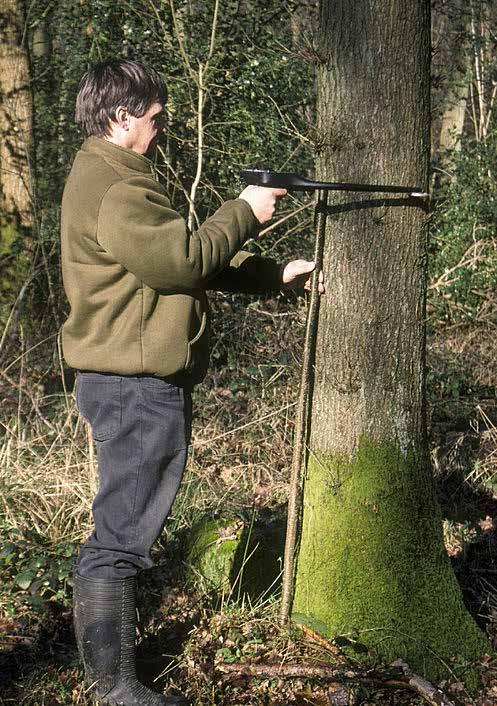
such as parkland, the growth rate will be nearer 2.5 centimetres annually. So by measuring the trunk circumference and dividing by 1.5, 2 or 2.5 you can get a good idea of age. However, trees will grow at different rates depending on how good the soil, shelter or climate is and how much space and light they have.
Conifers, these commonly show a regular pattern of growth, producing a whorl of branches each year. So if you follow the main trunk up, you can see a whorl of branches all radiating out from the trunk at the same level, followed by a clear section, then another whorl and so on. Counting the number of whorls up the trunk gives an idea of the tree’s age and also how fast it has grown. This is easier in younger trees obviously!
“Trees sound different at night, and they smell different too.”
Marilynne Robinson (novelist)
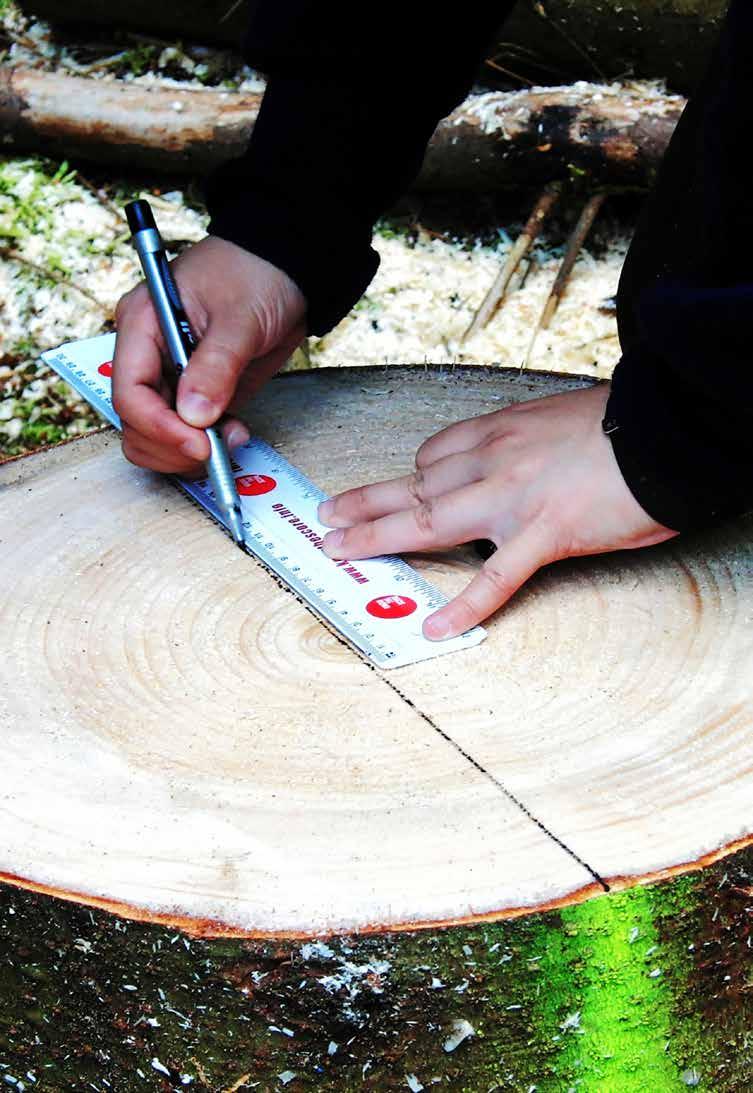

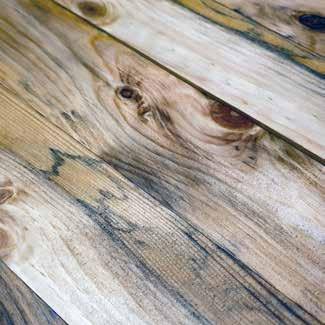
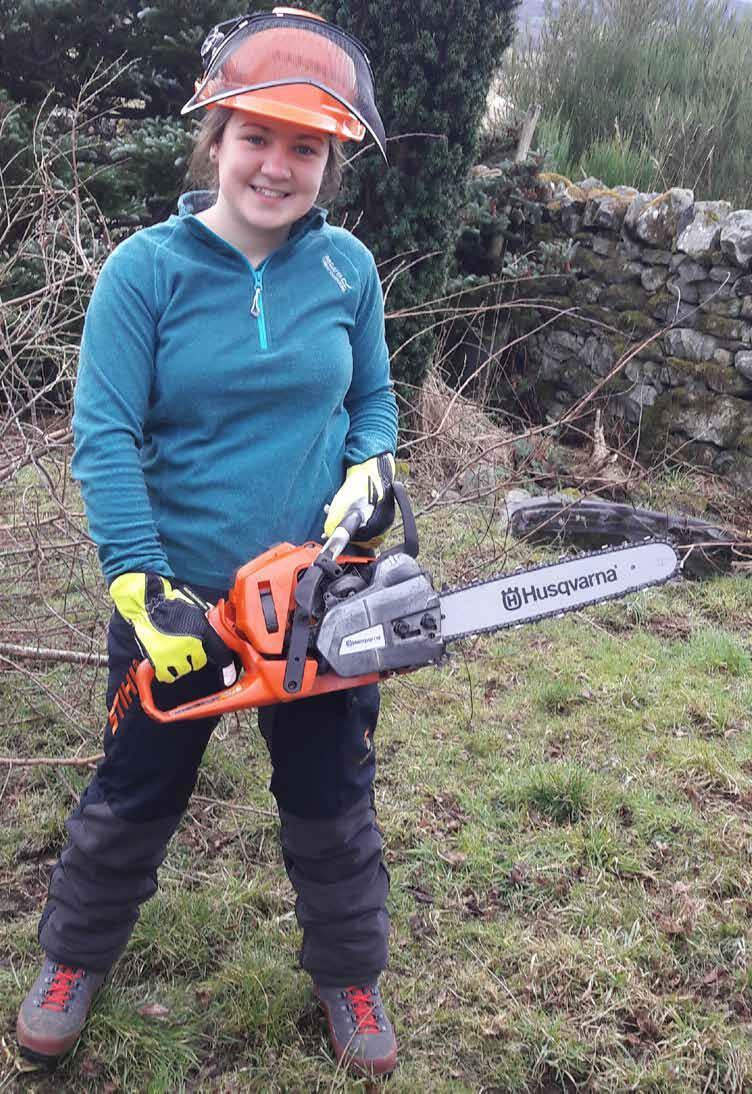
“Give me six hours to chop down a tree and I will spend the first four sharpening the axe.”
Lincoln
Just as our forests are important, it is also important that we management them correctly. The UK Forestry Standard (UKFS) is the reference standard for sustainable forest management across the UK, and applies to all woodland, regardless of who owns or manages it. The standard ensures that international agreements on work in sustainable forest management, climate change, biodiversity and the protection of water resources are applied and in the right way. The UKFS sets out the approach to sustainable forest management by defining requirements and guidelines, and providing a basis for regulation and monitoring - including national and international reporting.
The UKFS covers key elements of sustainable forest management:
Biodiversity
Climate change
Historic environment
Landscape
People
Soil
Water
The Forestry Commission in England, Scotland Forestry, Natural Resources Wales and the Northern Ireland Forest Service are the main bodies responsible for implementing the UKFS. These bodies assess forestry proposals against the UKFS before giving approval and carry out checks to ensure woodland owners and managers comply with forestry regulations. The precise arrangements for implementing and monitoring the standard vary between the four countries.
The extensive (200+ pages) guidance can be found here: https://www.gov.uk/government/ publications/the-uk-forestry-standard
A review takes place every five years and the aim is to update and publish the next version by the end of 2022.
The Forest Stewardship Council (FSC) helps take care of forests and the people and wildlife who call them home. FSC is an international, non-governmental organisation dedicated to promoting responsible management of the world’s forests. They run a global forest certification system with two key components:
• Forest Managementhttps://www.fsc-uk.org//en-uk/business-area/ fsc-certificate-types/forest-management-fmcertification
• Chain of Custodyhttps://www.fsc-uk.org//en-uk/business-area/ fsc-certificate-types/chain-of-custody-coccertification
FSC also licenses retailers and other end users to promote FSC labelled products, without holding FSC certification.
The FSC system allows businesses and consumers to identify, purchase and use wood, paper and other forest products made with materials from well-managed forests and/or recycled sources.
FSC’s “tick tree” logo is used to indicate that products are certified under the FSC system. When you see the FSC logo on a label, you can buy forest products with confidence that you are helping to ensure our forests are alive for generations to come.
Sharing good practice and things that go wrong and where people have improved things helps the sector to learn and support each other better.
The alerts and good practice are shared by FISA regularly via the FISA website and it is worth checking their pages on a regular basis.
If you wish to share your learning points in confidence, they ensure the alerts and good practice are anonymous. If you need some help to complete the templates, send an email to technical@ukfisa.com with your contact details and a member of the group will get in touch with you.
FISA also produce a number of safety guides, which are available here: https://ukfisa.com/Safety/Safety-Guides
They are numbered for ease of reference and contain the industry agreed safe working practices which you need to follow. You should use these leaflets — as well as any manufacturers guidance if using machinery — as part of your risk assessment process and to identify any controls that you need to put in place. They are updated regularly so please always consult the website for the latest version.
FISA also has guidance on managing health and safety which is available here: https://ukfisa.com/Safety/Safety-Library/fisaguidance-on-managing-health-and-safety-inforestry
This guidance informs all those working in the timber supply chain, by clearly setting out roles and responsibilities.
All workers are entitled to environments where risks to their health and safety are properly controlled. Under health and safety law, the primary responsibility for this is down to employers, but workers also have a duty to take care of their own health and safety and that of
others who may be affected by their actions. Key to this is carrying out an effective risk assessment.
To do a risk assessment, you need to think about what might cause harm to people or the environment, and decide whether you are doing enough to stop that happening. Then you need to put in place the appropriate and sensible control measures.
Start by:
• Identifying what can harm people in your location
• Identifying who might be harmed and how
• Evaluating the risks and deciding on the appropriate controls, taking into account the controls you already have in place
• Recording your risk assessment
• Reviewing and updating your assessment.
There are no fixed rules about how a risk assessment should be carried out or what it should look like, but the HSE site has some very clear examples and case studies. There is also more information here from FISA, which includes an example for Mechanical Harvesting:
It should be clear from your assessment that a proper check was made and that all people who might be affected were considered. All significant risks should have been assessed with reasonable precautions put in place so that the remaining risk is low.

“Smithy.... How do I keep myself safe when I’m working in the forest?”
“Don’t worry! Your supervisor will talk you through the risk assessments and provide any training you need. Follow the safety instructions and signage, wear the right protective gear and you’ll be fine.
The signs below were produced by the Forestry Commission in conjunction with partners. They can be used by those working in and around forestry work sites and communicate a clear safety message to forest users.
Please ensure you use them. https://ukfisa.com/Safety/Safety-Signs
This gives the details of what’s available and how to get them.
Personal Protective Equipment (PPE) is the last line of defence against injury and must ALWAYS be worn, kept up-to-date and in good condition.
It is essential that anyone using a chainsaw either on or off the ground is provided with and wears appropriate PPE. Even non-chainsaw users may also need to wear appropriate PPE, for example head, hearing or eye protection as identified in the task risk assessment.
Further information on the standard of equipment required can be found here: https://www.hse.gov.uk/treework/safety-topics/ chainppe.htm
We are working
site
In forestry you are likely to come into contact with machinery every day, which brings with it associated risks. This is why only those who are authorised and familiar with the safe operation of the equipment or those undergoing supervised training should operate machinery.
Workers should not use a machine unless they are properly trained and know how to use it safely. Before using any machine, consider the following:
• Is the machine you intend to use suitable for the job?
• Are all involved (including contractors) properly trained to do this job/use this machine and are they/you competent to do the job safely?
• Has the work been properly planned and communicated to those who may be at risk and has a risk assessment been carried out?
• Has the instruction manual and any other relevant information for the machine or site been provided, read and understood? For example, information from the risk assessments.
• Is the right personal protective equipment (PPE) available and worn? For example, safety boots should usually be worn when using machinery and operators should wear clothes that will not snag on machinery or controls. Any jewellery (including watches and rings) that might snag should be removed and long hair tied back so it does not get caught up in moving parts.
• Are all safety devices such as guards in place and working correctly? This is a legal requirement.
• If two or more people are involved, has everyone understood what needs to be done and has a clear system of communication been agreed upon?
• The terrain on a forestry site can be more challenging if steep or wet. Have you taken this into account?
Risks should be discussed regularly either within the team or with your supervisor. It is also good practice to carry your mobile phone with you at all times. Do not leave it in the cab even if ‘just nipping out’. You should also consider downloading ‘What3Words’ to your phone for aid of location identification should something happen. Complete your In Case of Emergency and ensure you have emergency contact numbers on your phone.
Before working with any machinery, you need to carry out a basic check to make sure that it is in good working order and safe to use. This should include:
• Carry out any pre-use checks as specified in the operator’s manual.
• Guards and other protective devices like Power Take Off (PTO) shaft guards are correctly fitted and maintained in good condition.
• Check that stopping devices are functioning correctly and labelled! e.g. emergency stops.
• Mechanical defects – pay particular attention to items such as brakes, wheels and tyres.
• Hitching and attachment points – check the machine has been safely attached to the towing vehicle. Pay attention to the condition of drawbar/pick-up hitch, and hitch rings, pins, clips etc.
• For self-propelled machines, make sure mirrors are clean and properly adjusted. Check any other reversing aids are working.
Machinery controls can vary between manufacturers and so should be clearly marked to show what they do.
If workers are to be carried on the machine you should ensure this will be done safely, for example through a safe means of access and use of guard rails.
When you are working with a machine, first check your surroundings. Are there children or visitors nearby for example? Ensure you are wearing high visibility clothing to make sure that others can see you.
You should also:
• Always follow Safe Stop if you or anyone else needs to check equipment, carry out maintenance work or clear a blockage. This means you need to:
• Engage the handbrake
• Put the controls into neutral
• Switch off the engine (or turn off power)
• Remove key (or lock-off the power supply)
• You should always do this before leaving the driver’s seat/operating position.
• Never approach, walk behind or beside a reversing vehicle. If you must approach, first attract the driver’s attention and get them to stop.
• Don’t remove or defeat guards (e.g. by overriding safety devices) in order to allow the machine to work quicker or to avoid blockages or other problems.
• If guards become damaged or defective, stop work and take action to get them fixed. Don’t leave it until later.
• Don’t run the machine when the guards are removed and never step across a rotating power shaft, always walk around the machine.
• Replace all guards before making a test run and check the machine before restarting, checking first for bystanders and warn them before you restart the machine.
• If the machine is to be checked again after the test run, repeat all safety procedures –especially Safe Stop!
• Keep a safe distance from machinery when it is in use, due to the risk of chainshot, debris or falling trees.
Always follow the Safe Stop procedure before carrying out any interventions and follow the manufacturer’s instructions/procedures, e.g. as set out in the operator’s manual.
Use the right tools for the job. The wrong tools may not work, cause damage or create additional safety risks. Also remember to secure anything which could fall on you and anything which could move or rotate.
Energy may be stored e.g. in springs or hydraulics. You need to consider how will you stop this energy being released or release it safely and remember that machine components may suddenly move when a blockage is cleared.
Use purpose-designed access points and platforms where provided and where they are not, make sure you take time to consider what is the safest means of access, e.g. with measures provided to prevent falls.
When the job is finished, always replace the guards before running the machine – this is a legal requirement.
Check the machine over and make sure that people are well clear before restarting.
• Use a machine unless you know how to use it safely and have received suitable training
• Attempt to clear blockages or clean a machine unless you have followed the ‘Safe Stop’ procedure, the drive is disconnected, the machine is stationary and components have stopped
• Wear long chains, loose clothing, gloves or rings, or keep long hair loose, which may get caught up in moving parts
• Distract people who are using machines
• Mount or dismount from a moving tractor or other self-propelled machine.
A fall from height can be fatal or lead to long term injuries and includes any activity that takes place ‘off the ground’ – even just getting into, or out of, a tractor. Most accidents of this type could have been prevented by better planning and risk assessment, or by checking that equipment is safe and in good working order.

The key steps to work through are Avoid, Plan, Prevent and Train.
• Avoid – This is of course the best option, though not always possible. Try to do as much work as you can from the ground.
• Plan - Plan the task properly using safe equipment, making sure you consider whether specialist operators would be better placed to undertake the activity. Ensure that you can get safely to and from where you will be working at height. Provide protection from falling objects (e.g. hard hats) and ensure you have considered your emergency evacuation and rescue procedures (see Appendix 1 for an example Emergency planning form).
• Prevent - Preventing a fall is better than mitigating the fall (e.g. with air bags), so where possible edge protection should be used. This is designed to prevent persons and objects from falling to a lower level’ and includes Mesh Barriers, Net Barriers, Counterweight Systems, Screen Protection and Tubular guardrails. Each one offers different benefits and limitations so it’s important to pick the right edge protection for each situation. You should also check any equipment or machinery is stable, strong, well maintained, and suitable for the task to be done. Do not overreach and take precautions when working on or near fragile surfaces.
• Train – ensure that you or your team have all had the appropriate training if required to work at height.
You will find more information here: https://www.hse.gov.uk/pubns/indg401.pdf
Overhead lines are common and can cause a serious or lethal shock, even without direct contact as, at high voltage, electricity can jump gaps. So a great deal of care should be taken when working in their vicinity, even if working inside machinery.
Overhead lines are common and can cause a serious or lethal shock, even without direct contact as, at high voltage, electricity can jump gaps. So a great deal of care should be taken when working in their vicinity, even if working inside machinery.
Always:
• Plan the job carefully, making sure you have in place preparations to do the work safely from beginning to end.
• Identify areas of the site where it is unsafe for machinery like forwarders, harvesters, cranes, tippers or tele-handlers and mark these on the map.
If an accident occurs:
• Call for help immediately - 105 is the national number for power emergencies in the UK. Your call will be directed to the local electricity distribution company and you can ask them to immediately disconnect the power line due to the accident.
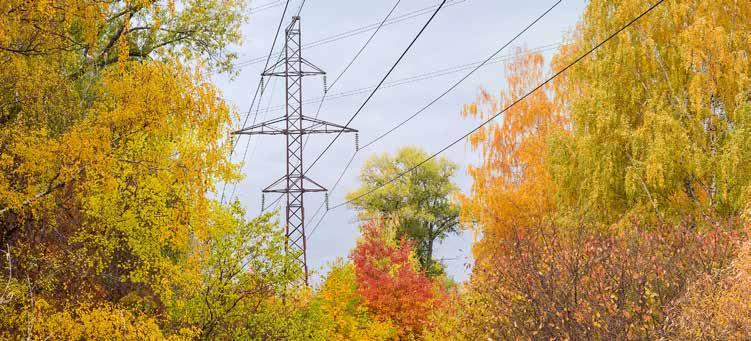
• Call the emergency services on 999 or 112 and explain the nature of the incident.
• Stay calm and keep clear – if a piece of machinery or equipment has made contact with the overhead power line, touching that equipment could be fatal. Meanwhile the driver or operator should be safe if they remain in the cab - keep everyone out of the way and away from the vehicle.
• If someone has been injured – maintain a safe distance but tell them either to remain in the cab until the electricity company confirms the power is off or to drive clear of the wires if they can. If they have to leave the vehicle, they should jump clear and make leaping strides until they are at least 5 metres away.
• Do not return to the vehicle.
FISA 804 Electricity at Work is a useful resource and can be found here: hyperlinkhttps://ukfisa.com/Safety/Safety-Guides/fisa-804 https://www.yellowwellies.org/ - The Farm Safety Foundation has some excellent resources, including a guide for temporary workers. http://yellowwellies.org/FarmSafetyMessage_ TemporaryWorkers_0420/FarmSafetyMessage_ TemporaryWorkers_0420/?page=1 https://www.yellowwellies.org/farm-safetyaugmented-reality-experience/ and much more.
It is also important that we look after our mental wellbeing. For some this means talking about how you feel, or how well you are coping with day-to-day life. Good mental wellbeing doesn’t mean you’re always happy or unaffected by your experiences. But poor mental wellbeing can make it more difficult to cope with daily life.
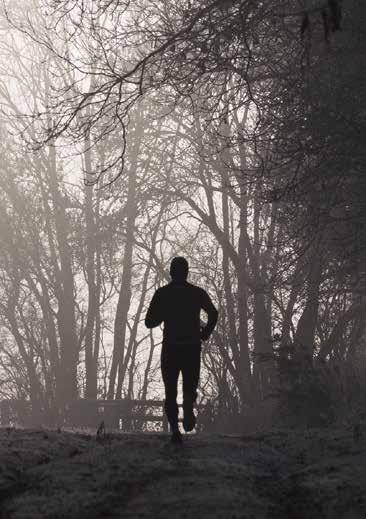
https://www.nhs.uk/mental-health/self-help/ guides-tools-and-activities/five-steps-tomental-wellbeing/
https://www.mind.org.uk/information-support/ tips-for-everyday-living/wellbeing/wellbeing/
When starting out in a new role, there can be pressure (often from ourselves!) to work longer hours and to not ask too many questions, when in reality, pacing ourselves and ensuring that what we are doing is correct and safe is better for all concerned. It is also worth remembering that an employer’s duty of care doesn’t just apply to safety. It includes all aspects of your health and wellbeing, including mental health. As well managing day-to-day risks, your employer should check that you are:
• Not working excessive hours;
• Protected from bullying and harassment;
• Free from discrimination; and
• Aware of who to turn to when raising any concerns.
This isn’t just a legal duty - but also great business practice. Supported employees are more productive, less likely to leave and take less sickness absence.
If unsure – ask. No matter how experienced your supervisor – they were a newbie once too.
You may have a mental health problem that you feel you can’t tell your employer about it because you are worried about how they might react. However, if you have a mental health problem that is a disability and you want the protection of the Equality Act, your employer needs to know this.
If you do decide to tell your employer, think about:
How and when to do it - It can be helpful to have a note from your doctor to help explain your situation.
How much information you want to give. You don’t have to go into personal details, just focus on how your mental health problem impacts on your job.
Whom to share it with. For example, the human resources (HR) department may know your diagnosis, but they don’t have to tell your supervisor or colleagues.
For more information about telling your employer about your mental health problem, or on how to be mentally healthy at work click here: https:// www.mind.org.uk/information-support/tips-foreveryday-living/how-to-be-mentally-healthy-atwork/work-and-mental-health/
Diffuse pollution is defined by The Scottish Environmental Protection Agency (SEPA) as the release of potential pollutants from a range of activities that, individually, may have no effect on the local water environment, but, at the scale of a water catchment can have a significant effect. This can occur in both rural and urban environments.
A water catchment is an area of land through which water from rain, melting snow or ice, drains into a river, lake or reservoir, or even into underground water supplies – ‘groundwater’.
In rural areas this can include:
• Run-off from forestry activities
• Run-off from farmland
• Run-off from community and amenity green spaces.
Urban problems include:
• Seepage into groundwater from developed landscapes of all kinds
• Run-off from roads, houses and commercial areas
• Yard run-off from industrial activities.
The UK Forestry Standard sets out the standards, requirements and regulations concerning sustainable forest management and how these apply in a UK context. https://www. forestresearch.gov.uk/tools-and-resources/ fthr/uk-forestry-standard/
The UKFS guidance on reducting the impact of diffuse pollution is also available from Forest Research at https://www.forestresearch.gov.uk/ publications/managing-forest-operations-toprotect-the-water-environment/
You can download a pocket guide here: https://www.confor.org.uk/media/2678359/ know-the-rules-booklet-2nd-edition.pdf
There is guidance for Wales here: https:// cdn.cyfoethnaturiol.cymru/media/4059/ diffuse-water-pollution-in-wales. pdf?mode=pad&rnd=131596369370000000
In Scotland, activities likely to cause diffuse pollution are regulated by the Water Environment (Controlled Activities) (Scotland) Regulations 2011 (more commonly known as the Controlled Activity Regulations (CAR)) and their further amendments. https://www.sepa.org.uk/regulations/water/ diffuse-pollution/
Is an initiative to reduce diffuse pollution through improved forestry practice. The initiative involves various organisations involved in Scotland’s forestry sector and by the Diffuse Pollution Management Advisory Group (DPMAG), a partnership that focuses on protecting and improving Scotland’s water environment by reducing rural diffuse pollution. http://www.confor.org.uk/resources/forestrywater-scotland/
Pollutants can get into drains, ditches and groundwater and can end up in a watercourse many miles away from their source. Just a small amount of pollutant can damage a long stretch of watercourse. They get trapped in sediments and carried along, being released slowly and causing a wide and potentially long-term impact on drinking water supplies, the water environment, fish and wildlife. Forest works managers and contractors should focus on preventing pollution rather than remediating it, because prevention has less environmental and financial cost.
In forestry, the risk of diffuse pollution is increased by:
• Poor site-planning, management and monitoring.
• Not understanding each other’s responsibilities on site.
• Conditions such as high rainfall, heavy machinery and steep ground.
“Good timber does not grow with ease. The stronger the wind the stronger the trees.”
Thomas S. Monson
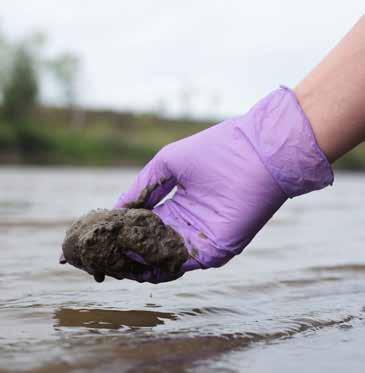
The five key steps to reduce the risk of diffuse pollution are:
1. Understand the site – topography, soil, water and drainage.
2. Identify the risks to water and what measures are needed to avoid those risks.
3. Monitor conditions and if needed, change your work plan.
4. Mark out buffer areas and disconnect roadside drains from watercourses before work commences.
5. Know your role and responsibilities.
This applies to all watercourses and the drains and ditches which connect to them. Forestry operations near water require buffer areas to be put in place, within which certain operations cannot be undertaken. The width of the buffer depends on the width of the watercourse.
Steps to reduce pollution must be taken before operations begin, and this needs planning and communication.
Before the pre-commencement meeting Forest Works Managers must ensure that:
• There are adequate resources for reducing the risk of pollution and dealing with incidents.
• There is a pollution prevention plan, which determines how water will be managed on site under different weather conditions, and a contingency plan for pollution incidents.
• Sensitive areas are identified in the operations plan and on site - and they match.
• Only machinery and techniques appropriate for the site and working conditions will be used.
• Relevant licences (e.g. to install a culvert) are in place before operations begin.
At the pre-commencement meeting Forest works managers should:
• Give out and discuss the “Know the Rules” booklet and the Keep Your Distance vehicle sticker with all contractors, so that everyone
on site understands good practice. This includes contractors who start work after operations are already underway.
(The above booklet applies to Scotland. The equivalent guidance for England and Wales can be found here: https://www.forestresearch. gov.uk/publications/managing-forestoperations-to-protect-the-water-environment/
• Assign roles and responsibilities clearly, e.g. who is responsible for disconnecting drains from watercourses.
• State who to contact under what circumstances.
Contractors should:
• Make sure they understand the operations plan.
• Be able to identify risks to water that might arise and sensitive areas on site such as buffer areas, wetlands and designated areas.
• Ensure that all machinery is well maintained and regularly inspected.
• Know what action to take in case of a pollution incident.
Good water management helps reduce diffuse pollution risks from forestry operations. In turn this benefits the forest environment and wider landscape, helps compliance with water regulations and the UK Forestry Standard, and plays a key part in managing a forest sustainably.
Forestry operations can disturb and contaminate private water supplies because the equipment used to treat this water can be easily overloaded or damaged, so extra precautions are needed on land that is near to, or drains to, a private water supply:
• Maintain site roads and access routes.

• Keep a 5-metre buffer along either side of a pipe.
• Avoid crossing pipes. If this is unavoidable, use a log bridge or steel plates.
• If a pipeline is disturbed or broken, repair as soon as possible and inform the local Environmental Health Department.
• On harvesting sites, clear all brash from the buffer area upslope of where water is taken from a spring (the abstraction point).
• On restock sites keep a minimum 10 metre buffer for chemical use.
• Use durable, inert materials for water-bound roads and tracks.
• Monitor all work, to make sure buffer areas and other measures to prevent pollution are being effective.
• Respond quickly if circumstances change and report all incidents to the Forest Works Manager.
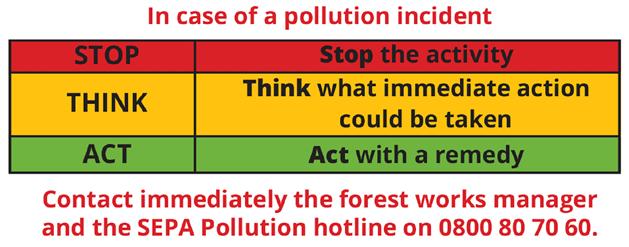
• Handle or store chemicals and oil on land that drains to the water supply.
• Allow sediment and debris to block intakes.
• Use machinery inside the buffer unless absolutely necessary, and only then with additional water protection measures in place.
• Put brash (i.e. lower branches that are dead and fallen, whether fallen naturally or been pruned) into heaps or extraction routes within buffer areas, nor put brash in streams.
• Ford across a watercourse.
• Excavate tracks, drains or borrow pits if the nearby source is a shallow spring flow.
Precautions are needed in source water catchments - the areas from which public drinking water is drawn. These sources provide drinking water for 97% of the Scottish public. Scottish Water can provide on-site toolbox talks — to talk you through what to do — for operations near public water assets.
In England and Wales about a third of public water is sourced from aquifers and 68% comes from surface water. The various local water authorities will provide equivalent guidance to Scottish Water.
• Store and handle fuel, oil and hazardous material outside the source water catchment.
• If this is not possible, keep a 50-metre buffer around all watercourses, boreholes and springs. Outside the 50-metre buffer, store and handle fuel, oil and hazardous material in dedicated areas.
• Keep a spill kit in all vehicles and plant.
• Manage sediment and debris so that it doesn’t block intakes or reduce storage capacity.
• Clearly mark the location of assets such as pipes, and protect all pipework used for the supply.
• If crossing a pipeline is unavoidable, use log bridges or steel plates.

• Use inert, durable materials for water-bound roads and tracks.
• Regularly maintain site roads and access routes.
Durable materials are inert, hardwearing materials that cannot be easily damaged.
Traditionally forest roads have been created using large materials or ‘as dug’ to create a formation, then a surface layer has been put on, for instance a 6 inch crusher run, and lastly the surface has been “blinded” and sealed using crusher dust or another such fine material.
Generally this created a very smooth running surface. However, these fine materials are very prone to erosion, wash out, and to entering watercourses. We know from research that these very fine materials are the ones that cause
us problems in watercourses as they can remain suspended in the water for some time and take a long time to settle. This style of road does not stand up to band tracks or thousands of tonnes of timber haulage running over them. After the trees, roads are the foresters most prized asset and cost from £60-100/linear metre to construct from new.
Two very different log bridges. The first photograph is of an extreme bridge built on Skye. You can see the metal road plates, which were used to spread the weight of the bridge on the banks of the river. The logs have been milled on two sides to provide a flat, uniform and stable structure. On this occasion sacrificial boards were fitted to the surface before coating with brash, so that they could use the milled logs again.
The second is a standard crossing before being covered with brash. Often the harvester operator builds them and the forwarder operator maintains them. In this example the harvester would normally put another layer of logs across the way (at 90 degrees to the machine) to spread the weight and make it more stable.
• Direct water into an adjacent catchmentdeal with it directly instead.
Ground preparation creates soil disturbance, so sediment run-off must be minimised. Disturbing soil during wet weather is particularly risky because of the likely increase in run-off, so avoid working in these conditions.
• Use the Keep Your Distance buffer widths as a minimum. Guidance for England and Wales can be found here: https://www.forestresearch.gov.uk/ publications/managing-forest-operations-toprotect-the-water-environment/
• Understand where sensitive areas are on site.
• Within buffer areas, limit cultivation to: 1) manual screefing (removal of vegetation and soil organic matter to form shallow mineral scrapes, the bottom of which will be used as the planting position); 2) inverted mounding (mound of earth turned over by an excavator and placed back into the hole); and (3) hinge mounding (mound of earth turned over by an excavator and placed next to the hole).
• Use silt traps and vegetated areas to reduce sediment run-off.
• Block drains which connect directly to a watercourse, e.g. with logs.
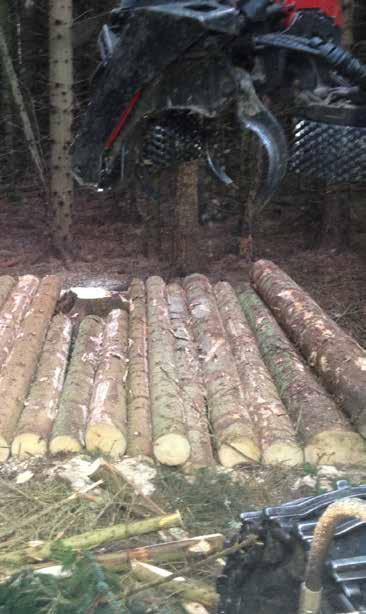
• Minimise water crossings; use pipes and log bridges if this can’t be avoided.
Above shows the large hole that has been dug as the silt trap with the geo textile used to a) act as a dam and b) provide an element of filtration, although not what it is intended to do!
The secret to silt traps is not to rely on one, but to install a series of them, a bit like locks on a canal. After each successive silt trap, the water should be getting clearer and cleaner (or less turbid – see guide).
• Connect drains to watercourses.
• Lay a drain at a gradient steeper than 2 degrees.
• Operate machinery or equipment in water.
• Cultivate waterlogged ground.
A silt trap or sump acts as a sediment trap for dirty water run-off and will catch most large sediment. They should be made large enough to cope with heavy rainfall, though more can be installed if weather conditions deteriorate or the working area increases. Trapped sediment can be removed at regular intervals; the rest can be dealt with by the surrounding vegetation, which will act as a natural filter but make sure you direct the silt trap’s outlet onto a well-vegetated grassy area. To remain effective, they must be regularly monitored and maintained.
Above shows the large hole that has been dug as the silt trap with the geo textile used to a) act as a dam and b) provide an element of filtration, although not what it is intended to do!
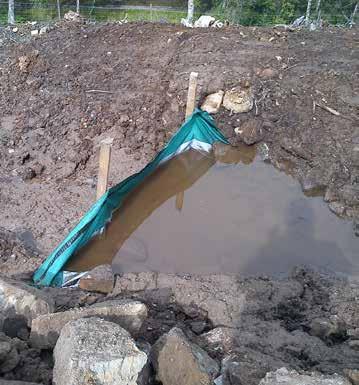
The secret to silt traps is not to rely on one, but to install a series of them, a bit like locks on a canal. After each successive silt trap, the water should be getting clearer and cleaner (or less turbid – see guide).


Good fertiliser management means targeting relevant areas and avoiding excess use, which can cause nutrient run-off and excessive weed growth. This can cause poor oxygen levels in watercourses, which in turn affects fish and insects.
Fertiliser run-off can also compromise drinking water quality.
Do
• Apply only the amount of fertiliser required by the crop.
• Observe the Keep Your Distance buffers as a minimum
• Keep equipment in a good state of repair.
• In Scotland, inform SEPA if you intend to undertake aerial applications.
You will need a permit from the Health and Safety Executive (HSE) for aerial spraying and to follow an approved Application Plan. In Wales it is managed by both Natural Resources Wales and the local authority. https://gov.wales/sites/ default/files/publications/2021-03/waterresources-control-of-agricultural-pollutionwales-regulations-2021-guidance-for-farmersand-landmanagers.pdf
• Store fertiliser on land that is waterlogged.
• Store fertiliser within 10 metres of a watercourse (regardless of its width) or within 50 metres of a spring, well or borehole.
• Use organic fertiliser within buffer areas.
• Use in wet weather or if rain is forecast.
• Use on ground that is waterlogged, frozen or covered with snow.
Good pesticide management is essential to avoid contamination from storing, mixing, handling, and spraying.
• Keep pesticide use to a minimum.
• Observe the Keep Your Distance buffers as a minimum. Guidance for England and Wales can be found here: https://www.forestresearch.gov.uk/publications/ managing-forest-operations-to-protect-thewater-environment/
• Ensure users have a certificate of competence, or work under the supervision of someone who has.
• Comply with the instructions on the manufacturer’s label – especially around dosage and PPE.
• Ensure sprayers are correctly calibrated and kept in good condition; fix any leaks or drips before use.
• Clearly mark mixing and handling areas on site.
• Ensure the secure storage, removal and disposal from site of pesticides, packaging, containers and planting bags. More information on this will be available from the manufacturer or in the COSHH (Control of Substances Hazardous to Health) guidance.
• Store or apply pesticides within 50metres of a spring, well or borehole.
• Apply on frozen or waterlogged ground, or in wet or windy conditions.
• Soak any pesticide-treated planting stock in a watercourse.
• Fill sprayers directly from a watercourse.
• Wash any equipment or PPE in a watercourse.
Small, unintentional losses of fuel and oil during storage and handling can have serious consequences, especially to drinking water. This can be very costly to remediate.
Do
• Plan how fuel and oil will be stored, transported and handled so that spillage is prevented.
• Store in a sufficiently strong, lockable, bunded tank (tank within a tank) or container.
• Carry spill kits on all machinery, with an additional larger spill kit at the fuel storage/ service area.
• Use funnels when pouring from cans.
• Put waste or recovered oil in an oil-tight container and dispose of it at a licensed site.
• Put fuel bowsers (large containers or vehicles supplying fuel) on a stable site.
• Ensure machinery is well maintained and regularly inspected.
• Store or handle fuel or oil within 10 metres of a watercourse.
• Wash machinery within 10 metres of a watercourse or allow machinery washings into the water.
• Operate machinery that is leaking fuel or oil.
A road that is constructed badly and used by heavy vehicles can generate a lot of sediment run-off. This will pollute water if the roadside drains connect to a watercourse.
Do
• Ensure the operations plan for constructing or upgrading a road shows the location of road lines, watercourses and drains, buffer areas, and drinking water supplies and sources.
• Avoid working in wet weather as far as possible.
• Use durable material to reduce the risk of road deterioration and run-off.
• Disconnect roadside drains that connect to a watercourse, e.g. block them with logs. Ensure they discharge onto vegetation at regular intervals instead.
• Retain the vegetation that grows in roadside ditches because it is a natural filter for pollutants.
• Ensure culverts (a tunnel carrying a stream or open drain under a road or railway) are positioned below the bed level of the watercourse, and are maintained.
• Build a road within a buffer area.
• Allow large volumes of surface water to build up in roadside drains.
• Use multiple pipe culverts (used to be known as “Irish pipe bridges”) as crossing points –they prevent fish migration and can increase flood risk.
Forest works managers need to make sure that forest roads and associated drainage are maintained throughout all operations. Overloaded trailers and poor vehicle configuration (i.e. height, weight, width and length of a vehicle to include vehicle axle spacing) can damage and deteriorate forest roads, which can increase the amount of sediments and pollutants entering a watercourse.
Consider lorry configuration, paying attention to tyre pressure and the impact on road surfaces. See the Road Haulage of Roundtimber Code of Practice.
Report road defects and roadside pollution to the Works Manager.
• Check vehicles regularly to address fuel or oil leaks.
• Don’t damage the forest road network by overloading vehicles or using chained tyres.
Good quarry management means understanding how water moves around the site, and managing operations accordingly. Borrow pits are holes or pits that have been dug for the purposes of removing gravel, clay and sand used in a construction project such as when building an overpass or embankment.
Quarry run-off may or may not have a colour but it will contain pollutants that can seriously damage water quality. As emphasised earlier, silt traps/sumps and vegetated strips around the working area should be made large enough to cope with heavy rainfall and monitored and maintained so that they remain efficient
and effective. Quarries should be included in pollution prevention and contingency plans.
• Keep clean and dirty quarry water separate.
• Use silt traps and vegetated strips to collect and treat the run-off from quarry vehicles.
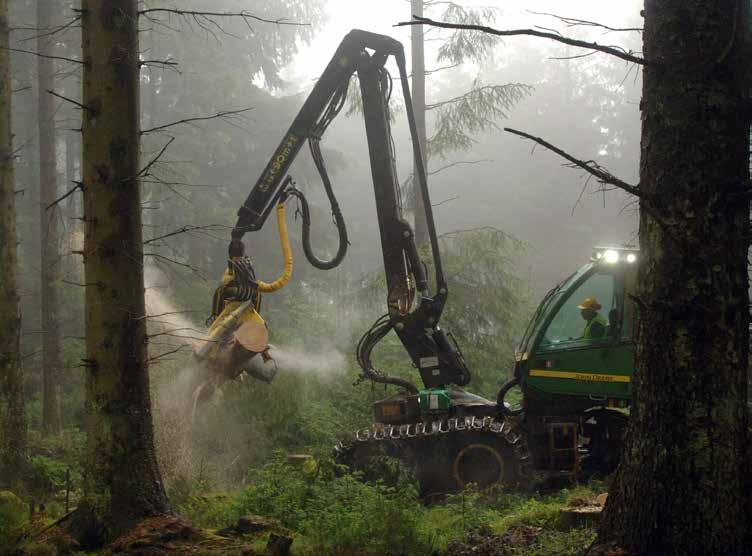
• Keep a fuel spill kit for machinery spillages.
• Allow quarry run-off to enter ditches or drains that connect directly into a watercourse.
• Position any static plant or equipment within 10 metres of watercourses unless on a drip tray or within a bund (wall surrounding fuel tank).
• Allow large volumes of clean water to enter the quarry.
• Allow the quarry entrance to deteriorate.

It is crucial to reduce soil disturbance and water run-off, by using things like brash mats, silt traps, disconnected drains and buffer areas before starting work.
Brash comprises branch tops and unmarketable material (e.g. under minimum dimensions for the products on site). A brash mat is used to drive on with the machines. It prevents soil compaction and provides a “floating road” by spreading the weight of the machine over a larger area. They are especially important on wet sites.
Observe the buffer widths on the Keep Your Distance sticker, and regularly check watercourses, particularly drainage outlets, for discolouration using the Turbidity ReadyReckoner (see later).
Harvesting operations on older sites may be unable to comply with current rules, so on these sites take extra care to reduce the risk of pollution.
Do:
• Provide and maintain appropriate areas for stacking, loading and turning vehicles.
• Follow the operations plan, paying particular attention to where the main extraction routes are.
• Fell away from watercourses; remove brash and tops from the water and buffer area.
• Stack from in-wood where possible. This means that rather than the forwarder coming out onto the forest road and stacking the timber from the road, the forwarder drives parallel to the road (but “in the wood”).
• Maintain brash mats, patching holes before they become waterlogged.
• Use brash or cut-offs to deflect water from the extraction routes onto the forest floor.
• When working on sites with little or no brash, use alternatives such as logs to deflect dirty water onto plateaus or flushes, digging out settlement ponds, or bringing in brash.
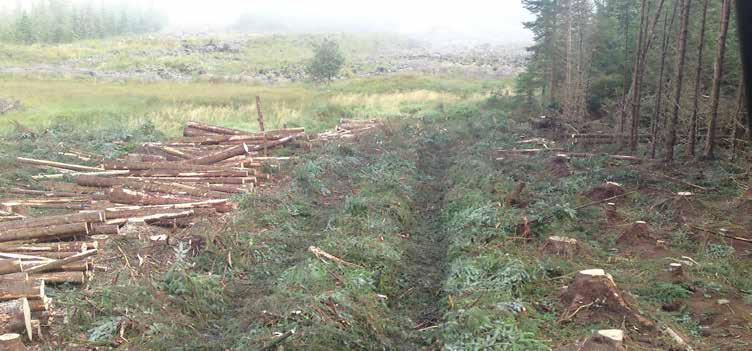
• Minimise water crossings; if a crossing is unavoidable use pipes and log bridges (and remove them when work is completed).
• Work sensitive areas only in drier conditions.
• Use band tracks only where necessary.
The images show tracks fitted to both front (bogie) wheels and also to the rear (single) wheel. In these examples, the tracks fitted to the bogie wheels are for traction/flotation whilst the tracks fitted to the single wheels are for traction.
The images show tracks fitted to both front (bogie) wheels and also to the rear (single) wheel. In these examples, the tracks fitted to the bogie wheels are for traction/flotation whilst the tracks fitted to the single wheels are for traction.
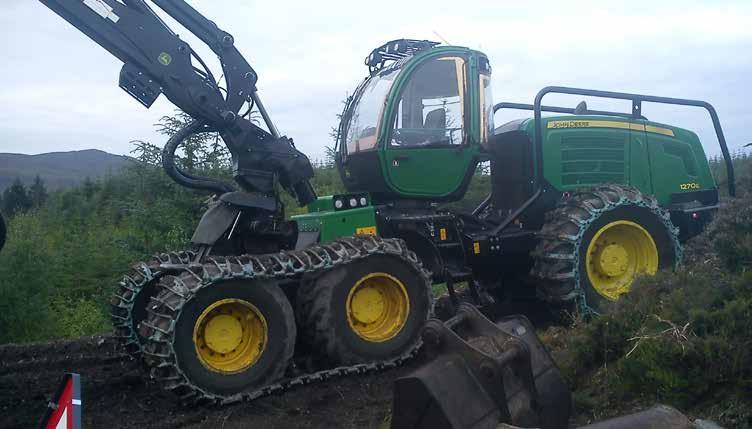
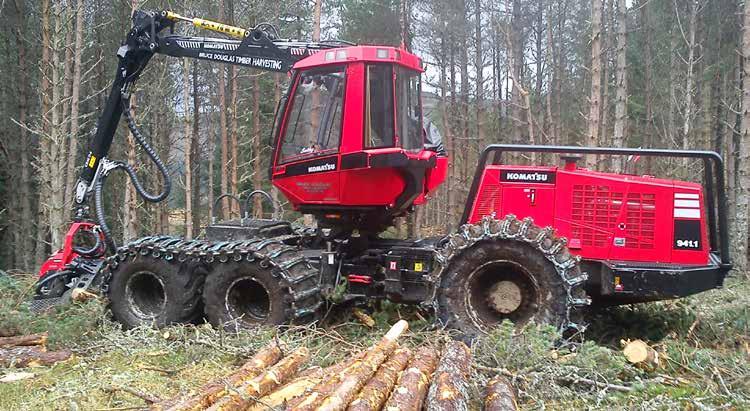
Water filtration. Nature is the best filter of water. In an artificial setting, slowing water down involves dropping the sediment so that it is held in suspension. This gives it a dirty appearance. Traditional water management was geared at getting water off site as quickly as possible using such means as drains and ditches.
Diverting water onto plateaus and flushesgenerally an open area of vegetation, preferably rushes and lush green grass - is current best practice to filter water and let it soak naturally into a water course. The vegetation acts as both a filter and slows the water down.
Settlement ponds are big holes in the ground that are excavated with an outflow that is higher than the inflow for them to work! Water is diverted into these, where it slows down, loses its energy and drops any silt before eventually flowing out the other side. Essentially they are big silt traps.
Band tracks are used to either improve traction or to increase flotation/decrease ground pressure. They are fitted to “bogie” wheels (they are in pairs) and form a band around the two wheels. Take a normal 8 wheeled forwarder e.g. a John Deere 1510. It weighs approximately 19 tonnes empty and has a load capacity of 15tonnes. But that weight is concentrated on the 8 small places it contacts the ground i.e. the bottom of the tyres, and is probably only an area 300mm long x the tyre width 710mm (0.213m2 per tyre/0.426m2 per bogie). By fitting band tracks, we fill the gap (at ground level) between the two tyres and create a much larger surface area in contact with the ground (1800mm x 710 tyre width=1.278m2/ bogie) so the weight is spread over a much larger area. We can also fit wider band tracks to increase contact area even more.
• Operate machines in watercourses.
• Run extraction routes where run-off is likely to enter a watercourse.
• Use tracked machines within sensitive areas (e.g. buffer areas, wetlands or designated areas), or for long distances on forest roads.
• Work sensitive areas during heavy rain.
• Stack timber in roadside drains or buffer areas.
• Let brash fall into buffer areas or streams.
By law, all waste must be stored and disposed of properly. Litter such as tree guards, planting bags, marker tape and warning signs must be collected and disposed of at appropriate locations. There are ‘take back’ and recycling schemes for items that have not yet disintegrated.
Do
• Include waste disposal in the operations plan.
• Know the health, safety and environmental risks of products used, and manage them accordingly.
• Put waste collection points in accessible places; monitor and empty them regularly.
• Get advice when dealing with hazardous waste.
• Ensure everyone disposes of waste responsibly.
• Discard any material into watercourses, ditches or drains.
• Puncture, bury or burn empty containers.
• Leave any material on site after operations are finished - planting bags, tubes, containers, packaging, fencing, signs, markers, etc.
Turbidity is the cloudiness or haziness of a fluid caused by large numbers of individual particles that are generally invisible to the naked eye. The measurement of turbidity is a key test of water quality.
The turbidity of a water sample is a good indicator of the amount of sediment coming from site drainage, so measuring it will test how clean the water is. The turbidity ready-reckoner is a quick and easily way to monitor dirty water levels.
However, the increased frequency of extreme weather caused by climate change has already increased the likelihood of other risks such as fire and storm damage.
The ready-reckoner can be used, for example, to trace the source of pollution after noticing a discoloured watercourse or when inspecting silt traps/sumps and site drains to ensure they are working effectively.
Firstly you would take a sample bottle and fill it from the silt trap/sump exit point, taking care not to scrape in the bottom of the channel or drain as this will mean your measurement is inaccurate.
Then place the sample bottle against the ready reckoner’s white background (see below) and compare the colour of the sample against the chart. A record of the turbidity measurement taken at each site visit should be recorded in a notebook. Turbidity is measured in National Turbidity Units (NTU). For additional information about best practice, the rules and reducing pollution risk see
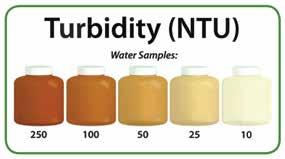
Scotland: www.forestrywaterscotland.com www.sepa.org.uk/media/34761/car_a_ practical_guide.pdf
England: https://www.forestresearch.gov.uk/ publications/managing-forest-operations-toprotect-the-water-environment/ Wales: https://naturalresources.wales/about-us/ strategies-and-plans/wellbeing-objectives/ reduce-the-risk-to-people-and-communitiesfrom-environmental-hazards-such-as-floodingand-pollution/?lang=en
The UK’s forests play an important role in helping to mitigate the impacts of climate change.
In England you should follow the countryside code (then the link) and then the before the welsh link should be: In Wales, there is guidance here: https://naturalresources.wales/days-out/thecountryside-codes/the-countryside-code-advicefor-countryside-visitors/?lang=en which contains advice for countryside visitors.
Most wildfires are caused accidentally, for example by people dropping cigarettes or not extinguishing campfires correctly. As well as the potentially negative effect on wildlife habitats, wildfires can burn valuable carbon stores (trees and peatland), releasing greenhouse gases back into the atmosphere.
In Scotland, follow the Scottish Outdoor Access Code’s advice and never start a fire during prolonged dry periods. If you see an unattended fire, please call 999 and ask for the Fire Service https://www.gov.uk/government/publications/ the-countryside-code Natural Resources Wales / The Countryside Code: advice for countryside visitors
The impact of climate change on future wind risk is uncertain, though wind risk is likely to increase as a result of climate change.
Forest stands in wetter soils have a higher wind risk, and increased rainfall may increase the risk to our forests. Wind risk also increases with tree height, and an increased growth rate as a result of the higher temperatures associated with climate change may mean forest stands present a greater risk at a younger age.
There is hence a drive to plant more diverse species that will thrive in the predicted future climate. Forests are being designed to make them more resistant to being blown over in storms; and adapting infrastructure to deal with more intense rainfall events. You are joining forestry at a challenging but also an exciting time, in which you can help make sure that we are as prepared as we can be for what the future might bring.
Healthy, thriving trees and forests are important habitats for wildlife, provide recreational facilities for people, and are key ‘players’ in our diverse and beautiful landscapes.
The threat to trees from pests and diseases is growing due to increases in global travel, economic globalisation, and the effects of climate change. Pests and diseases can spread rapidly in new habitats where there are few checks and balances (such as its natural predator). Beyond visible damage to leaves, shoots and bark, the impact on timber quality can have a serious negative effect on both the volume and value of forest products.
Biosecurity measures help to prevent the spread of non-native plants and animals as well as preventing the spread of pests and diseases.
Details of plant health controls and where to report a pest/disease or any other non-native plant pest can be found below and reported to the relevant authority.
England Plant health controls - Department for Environment, Food & Rural Affairs (Defra), Animal and Plant Health Agency (APHA)
Contact your local APHA Plant Health and Seeds Inspector or the PHSI Headquarters, Sand Hutton, York:
Tel: 0300 1000 313 (please select option 3 when calling) Email: planthealth.info@apha.gov.uk.
Scotland
Horticulture, Plant Health, Potatoes and SeedsThe Scottish Government
Contact the Scottish Government’s Horticulture and Marketing Unit: Email: hort.marketing@gov.scot
Wales
Plants, Seeds and Biotechnology - Welsh Government
Contact your local APHA Plant Health and Seeds Inspector or the PHSI Headquarters, Sand Hutton, York:
Tel: 0300 1000 313 (please select option 3 when calling)

Email: planthealth.info@apha.gov.uk.
Some species of insect have leaf-eating larvae capable of completely defoliating a tree; the caterpillars of the oak processionary moth (OPM) are a good example.
https://www.forestresearch.gov.uk/toolsand-resources/pest-and-disease-resources/ oak-processionary-moth-thaumetopoeaprocessionea/
Native to southern Europe, it has been found in recent years in southern parts of the UK and is now established in most of Greater London. The rest of the UK outside of Greater London and parts of southern England continue to be part of protected Zone for OPM. Officials are working to ensure that any interceptions are eradicated by spraying the nest with the pesticide Deltamethrin.
“Trees are as close to immortality as the rest of us ever come.” Karen Joy Fowler
“Keeping boots, bikes and paws clean will help slow the spread of tree pests and diseases https:/forestryandland. gov.scot/keep-it-clean.”
Ask Smithy! “Smithy.... What can I do?”
Anyone who has received oak trees imported from the continent has been asked to urgently check their trees for OPM, and nurseries holding imported oak trees have also been asked to spray them as a precautionary measure to stop this pest spreading.
The caterpillars can completely strip the leaves from an oak tree, but usually the tree is able to recover the following year. The hairs of these caterpillars are toxic to humans and can cause significant human health problems. It is important that you do not handle them or disturb their nests.
More information is available at https:// www.forestresearch.gov.uk/tools-andresources/fthr/pest-and-disease-resources/ oak-processionary-moth-thaumetopoeaprocessionea/opm-manual-1-introductionand-contents/
Anyone who has received oak trees imported from the continent has been asked to urgently check their trees for OPM, and nurseries holding imported oak trees have also been asked to spray them as a precautionary measure to stop this pest spreading.
The caterpillars can completely strip the leaves from an oak tree, but usually the tree is able to recover the following year. The hairs of these caterpillars are toxic to humans and can cause significant human health problems. It is important that you do not handle them or disturb their nests.
A gall is defined as a growth on a plant that is made of its own plant tissue but caused or triggered by another organism. These organisms might be insects, bacteria, fungi or viruses. Insect galls are the most common. For example, tiny gall wasps lay eggs on oak trees (where, depends on the wasp species) causing the plant tissue to swell up and form a gall. The gall provides a home for the larvae with protection from the elements and a handy food supply.
You can find some other examples here: https://www.woodlandtrust.org.uk/ blog/2018/07/galls-to-spot-this-year/
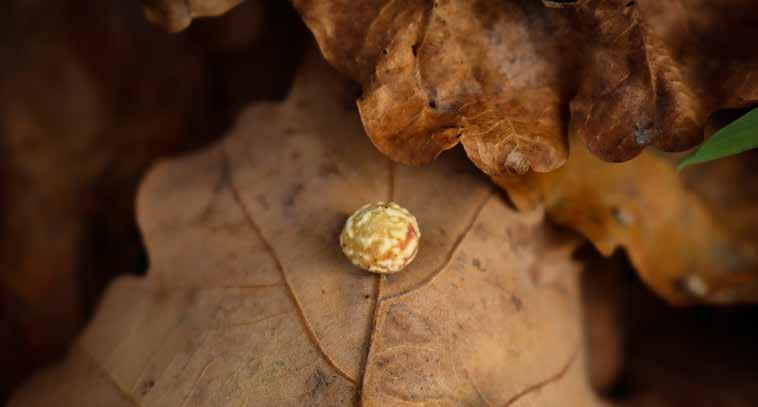
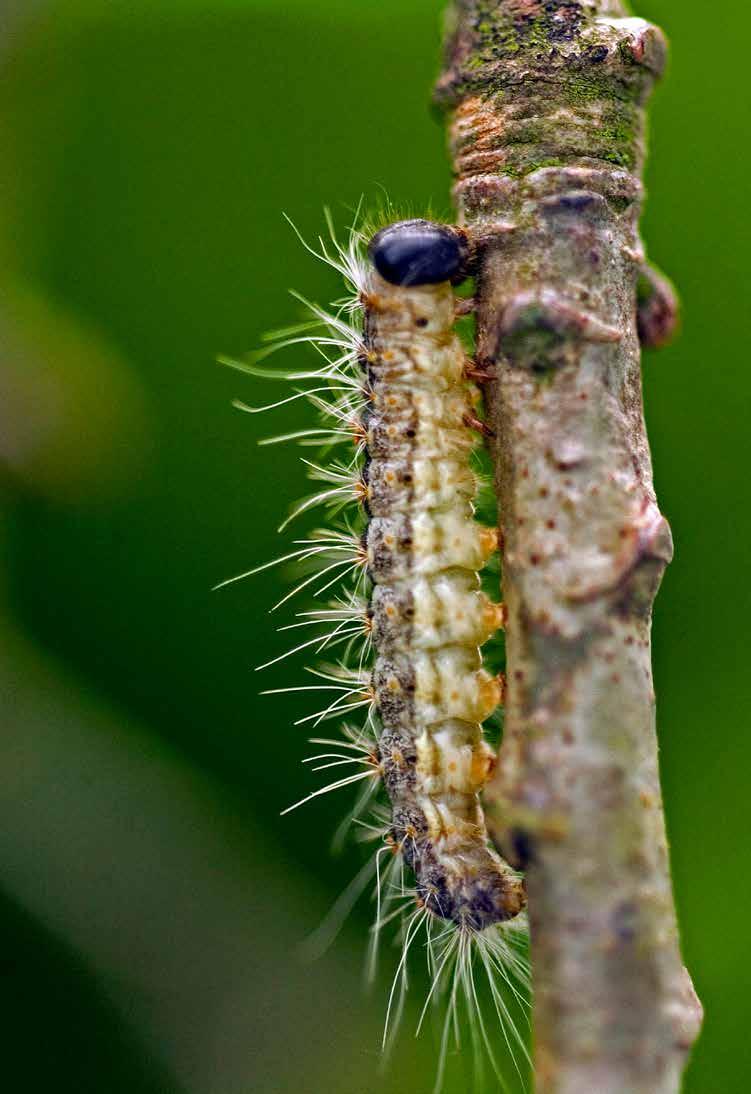
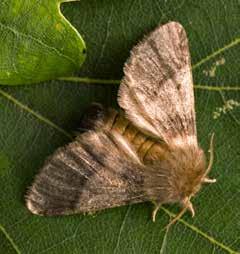

The common grey squirrel was introduced over 100 years ago from North America. They are now found throughout much of the UK, stripping bark from broadleaved trees and in some cases killing mature trees. For this reason grey squirrels are humanely controlled in many woods to keep damage to an acceptable level. The impact of grey squirrels can be seen in a 2021 report here https://rfs.org.uk/insightspublications/rfs-reports/an-analysis-of-thecost-of-grey-squirrel-damage-to-woodland/
More on grey squirrels can be viewed here: https://www.forestresearch.gov.uk/research/ management-of-grey-squirrels/ https://naturalresources.wales/permitsand-permissions/species-licensing/list-ofprotected-species/red-and-grey-squirrellicensing/?lang=en
Deer can have a serious impact on trees and woodlands when present in high numbers. Deer can damage trees by brushing against them, stripping the bark or fraying the trees with their antlers. Over the long term this can prevent tree regeneration, change the canopy structure and alter the characteristic ground flora of ancient woodlands.
In the UK, our two native species of deer have large populations: 350,000 red deer and 800,000 roe deer, though their numbers are very difficult to measure. In Scotland, there are estimated to be around 340,000 red, 300,000 roe, 25,000 sika and 8000 fallow deer. The Government has reported that deer numbers are now higher than they have been for 1000 years and therefore supports sustainable management, which includes humane control and providing a source of venison.
You can find out more via these links: https://www.bestpracticeguides.org.uk/ https://www.forestresearch.gov.uk/research/ impacts-of-large-herbivores-on-woodlands/ impacts-of-large-herbivores-on-woodlands-acase-study-on-integrated-deer-management/ http://www.thedeerinitiative.co.uk/best_practice/ https://naturalresources.wales/media/3114/wilddeer-management-in-wales.pdf
Other mammals such as field voles and rabbits may also damage trees and saplings by gnawing bark around the stem. This can happen when trees are in fields or orchards and surrounded by long grass.
Invasive non-native species such as American Signal Crayfish (ASC) can damage a large area of riverbank. Eggs and juveniles can be trapped in mud and transported off-site on machinery, then fall off and spread to other waters. ASC are highly destructive, and their removal can be expensivethey eat vegetation, fish eggs and small fish, and burrow 3 metres into riverbanks causing bank erosion. Seek advice from SEPA, SNH, the local Fishery Trust or FCS on where infected sites are. There are also some invasive plant species, which can cause problems for trees; the most notable of these is Rhododendron ponticum. Dense thickets of rhododendron can prevent regeneration of young trees and, in woodland, only those trees which manage to grow above the level of rhododendron can survive.
Rhododendron is also hst to the disease organism Phytophthora ramorum, which is linked to ‘sudden oak death’ (See later).
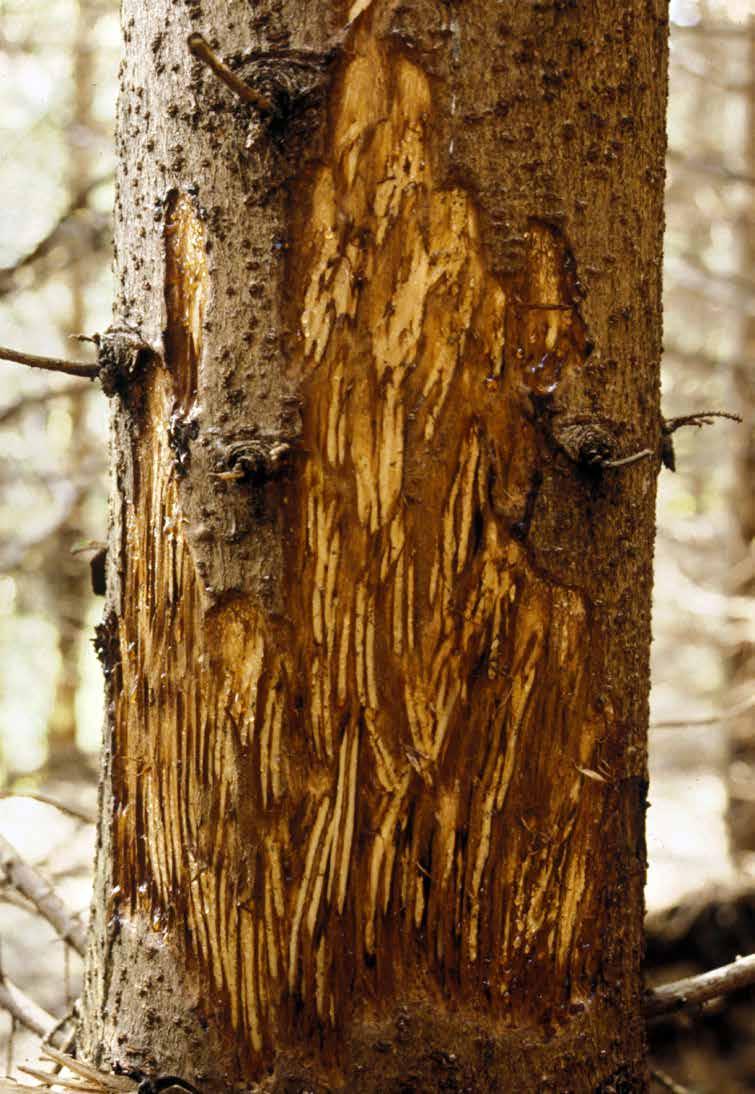
Like all living things, trees are susceptible to disease. A tree needs a good supply of light, water, carbon dioxide and nutrients from the environment for optimum growth. A lack of one or more of these may lead to reduced growth and put the tree under stress. If a tree is stressed, then it may not have the energy required to manufacture important defences and can become vulnerable to disease.
If a diseased tree eventually dies it can sometimes be difficult to diagnose the original cause because problems are often complex and cumulative. For example, a tree could be weakened by drought and then become the victim of a fungal attack; environmental factors such as temperature, storm wounds or pollution may play a part; or sometimes more than one disease may be present.
Tree disease can stem from fungal, bacterial or viral sources.
The main types of fungal decay are brown rots and white rots.
• Brown rots attacks cellulose in wood leaving only the lignin. The decayed wood becomes brown and cracked in a brick-like form and the tree may become brittle and unstable.

• White rots attack all parts of the wood, turning it into a pale spongy mass.
Fungal diseases are often only detected once the fruiting body of the fungus is visible, by which time it may be too late to act. Honey fungus (Armillaria spp.) is an example of a white rot fungus that causes the roots and butts of live trees to rot.
However, it is important to note that not all fungi damage trees. Many types of fungi enjoy a mutually beneficial (symbiotic) relationship with trees, whereby the fungi obtain energy from the tree sugars made during photosynthesis and the tree benefits from the absorption of additional nitrogen and phosphorous due to the fungal action in the soil.
The two most significant diseases in the UK today are sudden oak death caused by the pathogen Phytophthora ramorum and red band needle blight caused by the fungus Dothistroma septosporum which affects Corsican pine.
Oak decline is a complex disorder or syndrome in which the bacteria, along with other damaging agents such as insect infestation or weather damage, interact together and cause a serious decline in tree condition. There are two kinds of decline: acute and chronic.
• Acute oak decline affects mature oaks and in this case the bacteria causes ‘stem bleeding’ where dark, sticky fluid ‘bleeds’ from cracks in the tree trunk.
• Chronic oak decline takes longer to kill the tree. Early symptoms include deterioration of the leaves, which may be smaller than normal, and lighter in colour, with the death of twigs and branches following after.
Red band needle blight has increased dramatically in the UK and causes needle loss, which can kill the tree. The increase and spread could be due to a rise in rainfall during spring
and summer and warmer spring temperatures that encourage spore dispersal and infection. This means that climate change may increase outbreaks if warming trends continue.
Ash dieback is a serious disease of ash trees caused by a fungus called Chalara fraxinea (C. fraxinea). The fungus causes stem lesions, leaf loss and crown dieback in affected trees and kill the tree. Chalara was confirmed for the first time in the UK in 2012, when it was found in young trees imported from Europe. It is now found across the UK and management efforts are focused on mitigating safety risks from diseased trees, while allowing for natural regeneration of potentially disease-tolerant or resistant trees wherever possible.
https://www.forestresearch.gov.uk/tools-andresources/fthr/pest-and-disease-resources/ ash-dieback-hymenoscyphus-fraxineus/
Phytophthora ramorum affected very few trees in the UK until 2009, when it was found to be infecting and killing large numbers of Japanese larch trees in South West England. In 2010 it was found on Japanese larches in Wales, Northern Ireland and the Republic of Ireland. This change
in the pathogen’s behaviour was the first time in the world that it had infected large numbers of conifer tree species (see figure). Ramorum has not been detected in over 90% of the larch in Scotland though, underlining why continued control actions are necessary to slow down the rate, extent and severity of disease expansion.
Everyone working together to adopt new habits will have a positive impact on the forests we know and love. Keeping it Clean will help to slow the spread of tree pests and diseases – as well as helping to keep our forests healthy, it will buy us time to research and develop other actions that we can take to ensure the long term health of our woodlands.
https://forestryandland.gov.scot/keep-it-clean
To find out the latest developments, visit the Government’s Forest Research information pages.
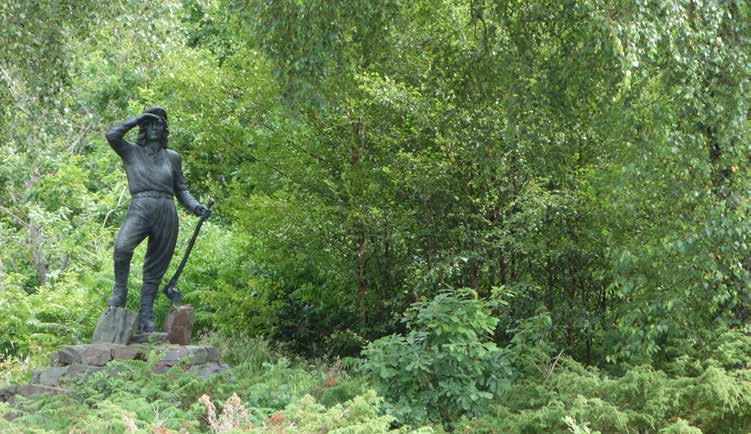
Tree pests and diseases can spread naturally via wind and water and animal migration. Although pests and diseases can spread naturally, the distance they travel is normally limited by environmental factors and their own physiology. However, human activity such as moving infected timber and wearing contaminated boots can have a big impact on the spread of these harmful organisms. Transport increases the potential to spread pests and diseases much further and faster because of the speed and distances we travel. We can also move a greater amount of infected material than what might be possible through more natural means.
What you need to do depends upon the activities or work that you do. For most people it is simple - Keep It Clean. Hidden fungi, bacteria and insects live in soil and organic materials and can be easily transported on your boots. So it’s really important to keep your boots, machinery and equipment clean. Always clean your kit between visits and if you have a four-legged ‘helper’ make sure you clean their paws after walks.
In terms of ‘kit’ you will need:
• Bucket
• Boot pick
• Stiff brush
• Disinfectant (Propellar and Cleankill Sanitising Spray have been confirmed as being effective against a number of plant pathogens)
• Hand sanitiser
• Water container or large reused water bottle
• Some people use portable pressure washers to clean larger items such as equipment.
You can buy a complete biosecurity kit at the click of a button, or you can pick up what you need at any hardware store.
Please ensure you apply disinfectant to a clean surface. It will not work on muddy surfaces so make sure you brush or wash off organic material before application.
For further information please visit: https://www.forestresearch.gov.uk/ publications/biosecurity-good-workingpractice-for-those-involved-in-forestry/
You should carry out basic biosecurity actions before entering and leaving each new site you visit, even if they are within the same area. Clean and disinfect footwear, tools and vehicles when moving between sites.
Symptoms of disease can take a while to develop, you can never be sure whether a site is free from pests or disease and it is better to be safe than sorry. Make sure you arrive at each new site clean and leave it the same way.
Always make sure you locate cleaning areas, especially those used for power-hosing away from drains and waterlogged ground and instead put them in well vegetated areas so dirty water runoff is captured for settlement and natural soakaway.
On all sites:
• Arrive with power-hosed clean equipment and vehicles and disinfected footwear.
• Use clearly marked cleaning stations on site.
• Ensure footwear and vehicles are clean before leaving site – this includes tyres, wheel arches and undersides.
• DON’T clean machinery, equipment or footwear in a watercourse.
On sites where watercourses are known to have invasive plants or animals take these extra measures too:
• Follow all biosecurity measures explained by the forest works manager at the pre-commencement meeting.
• Avoid coming into contact with infectious material.
• If contact has been made with infectious material, use a power hose to clean and disinfect all footwear, equipment and vehicles before leaving site.
• Don’t touch dead or dying material.
Commercial movements of certain types of regulated wood, wood products and bark within the UK and to relevant protected zones must be accompanied by Plant Passports or ISMP15 marks.
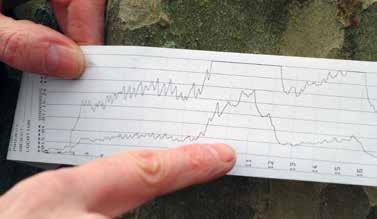
These include:
• All conifer wood with bark and all isolated bark of conifers, large conifer trees greater than 3m and foliage from these trees
• All sweet chestnut wood with bark and isolated bark of sweet chestnut
The adoption of timber plant passports for the movement of regulated material within the UK is now a legal requirement and will demonstrate
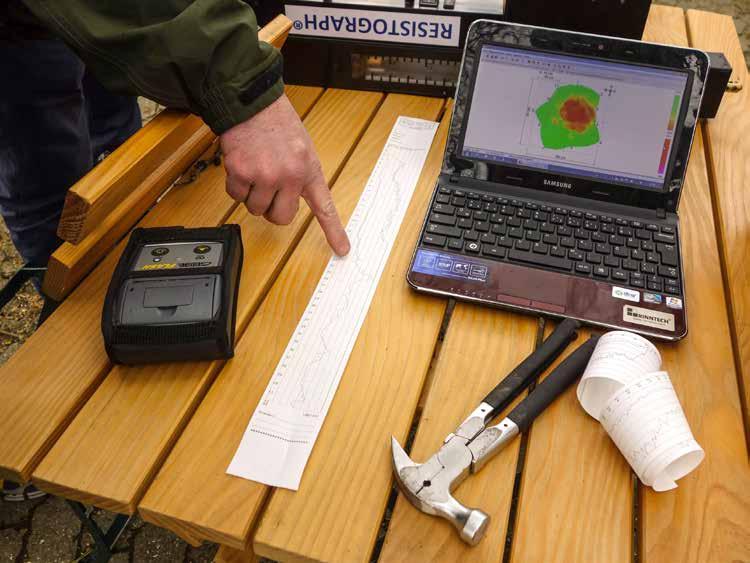
that the forestry industry is committed to the highest standards of biosecurity.
More details on plant passports can be found at https://www.gov.uk/guidance/issuing-plantpassports-to-trade-plants-in-great-britain
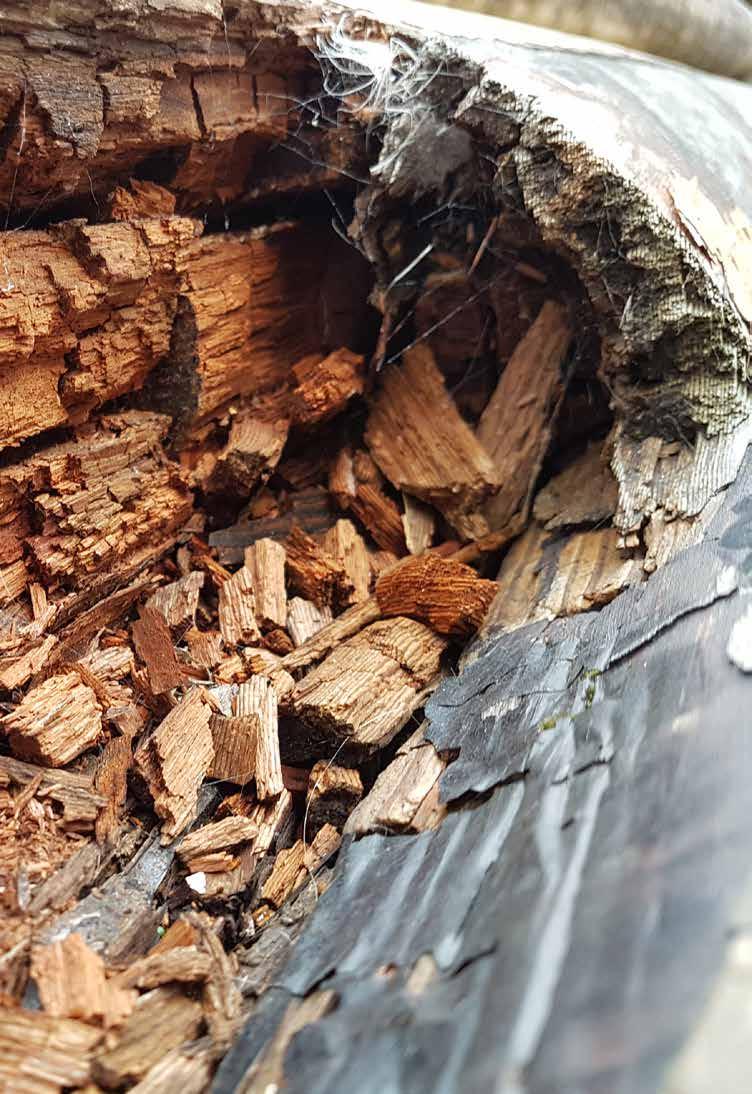

Under the Forestry Act 1967, it is illegal to fell trees in the UK without prior approval, although there are a few exceptions (for trees below a specified size, dangerous trees, and very small scale felling operations).
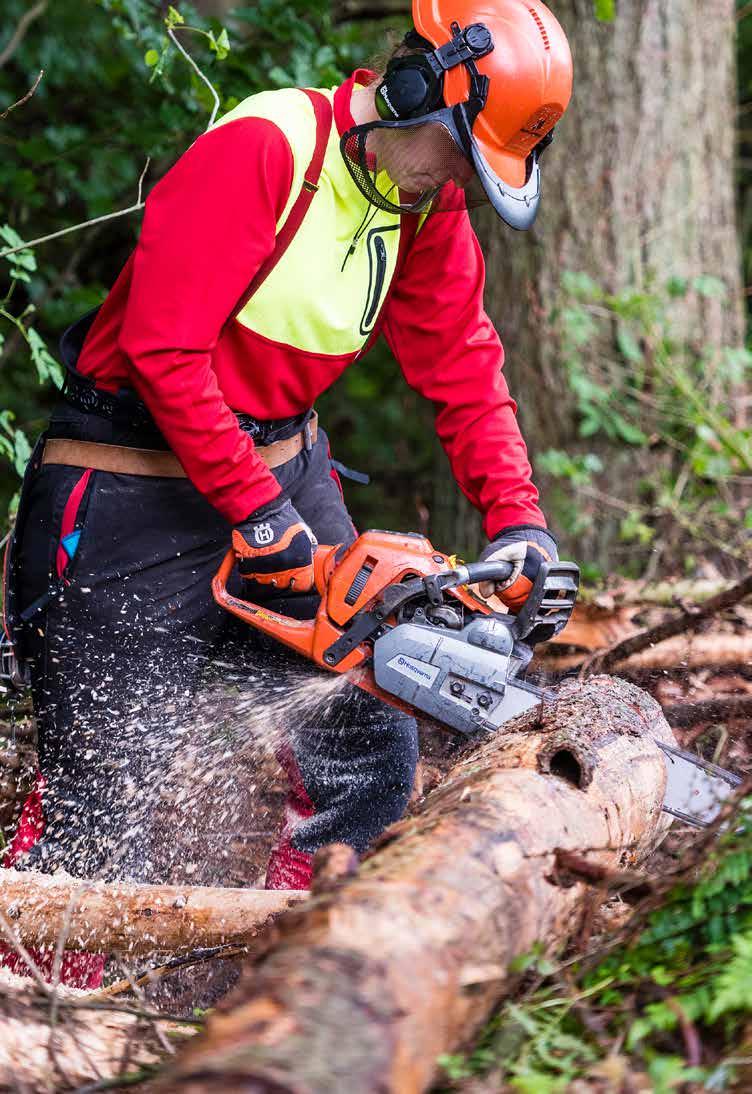

Jonesy… ecological assessments, management plans… all sounds like a lot of paperwork to me. Can’t I just go and plant some trees?!
Understanding the site and setting clear objectives is important. We need to get the right tree in the right place for the right reason and manage our forests sustainably for the future. Inappropriate planting or management can damage the environment.
The UK is committed to retaining our woodland and preventing loss of forest cover, so felling licences issued under the Forestry Act are normally conditional (where felling approval is granted subject to replanting). Approval for felling of trees in the UK is granted through felling licences. An unconditional license allows felling without the requirement to replant.
Unconditional licences are routinely issued for thinning operations and in these cases no woodland loss takes place. However, an unconditional felling licence without the requirement to replant may be issued if there are environmental considerations such as the restoration of important habitats.
The removal of trees may also be authorised under planning regulations, to enable development (including for wind farms). In this case, a felling licence is not required. The removal of trees might also be required through a Statutory Plant Health Notice (SPHN). A SPHN may require the felling and destruction of infected trees or containment of infested material on site, to prevent the spread of pests and diseases and you should note that sometimes these have a very specific timescale due to requirements of local flora and fauna.
For example there is a 1 kilometre radius exclusion zone around an active osprey nest during breeding season, which would prevent harvesting operations taking place. In the case of badgers, a license is required to fell trees on top of their set. Another example is in Kiltarlity, Scotland, where in order to prevent the moving of eggs and larvae of the pine tree lappet moth, timber is not allowed to be moved off site from May until the end of August. Similar actions are also required within the public woodland estate managed by these organisations. There is no legal requirement for woodland to be restocked after felling under a SPHN.
Wales https://naturalresources.wales/permits-andpermissions/tree-felling-and-other-regulations/ tree-felling-licences/getting-permission-to-felltrees/?lang=en
Scotland
https://forestry.gov.scot/support-regulations/ felling-permissions
A land management plan sets out how a specific area of land will be managed for a period of ten years. Usually the area covered by a plan is a forest or woodland, but it will often include open areas as well. It is important when these are created that local communities are included in consultation to ensure these forests balance the economic benefits of jobs and timber production with the social and environmental benefits of the forests being a pleasant, welcoming place to visit.
After a public consultation is complete, views are submitted with the updated draft plan to the local Scottish Forestry office for formal approval. The plan is also placed on Scottish Forestry’s register where the public can continue to comment for 28 days. You can find some Scottish examples here.
The Forestry Commission’s Register of Woodland Planting and Tree Felling gives details of proposed tree felling projects. Details of a tree felling application will stay on the register for 28 days. During this time, anyone may provide them with comments or additional information about the application or the impact that it may have on the area. You can also ask the Forestry Commission for more information on specific tree felling proposals.
Details of planned felling operation in Wales and how members of the public can comment on them can be found at: https://naturalresources. wales/permits-and-permissions/tree-fellingand-other-regulations/forestry-public-register/ felling-licence-register/?lang=en
A lot of people love maps, but if you aren’t used to deciphering their finer details, they can seem a bit challenging at first. Although you may use them mainly to plan a journey (such as in Google maps), they also show a range of other useful information that is important to be aware of and understand when working in Forestry.
There are different kinds of map, which can be presented differently. The one to the right is a Forestry and Land Scotland map, in which the woods are shown in green, with either a coniferous or non-coniferous tree printed over the top. Rivers and streams are blue lines with the width of the line indicating the width of the watercourse. If the width of a river is more than 8 metres it is shown as two blue lines with a light blue area between). The scale of a map shows how much you would have to enlarge it to get the actual size of the piece of land you are looking at.
For example, if your OS map has a scale of 1:25 000, this means that every 1 centimetre on the map represents 25 000 centimetres on the ground (i.e. 25 000 centimetres = 250 metres). To make it easier though - at the front you will see that the scale has been also written out like this: 4cm to 1km. This means that for every 4cm on a map that would be 1km and as the grid lines are exactly 4cm apart, every square is 1km by 1km.
https://getoutside.ordnancesurvey.co.uk/ guides/understanding-map-scales/
Ordnance Survey maps are covered in a series of faint blue lines that make up a grid. The lines have numbers that allow you to work out where you are located on the map. Once you have established this, the grid system makes it simple to give others (such as Mountain Rescue) an accurate description of your location. This description, which will be a series of numbers, is known as a grid reference.
Understanding the shape of the land by looking at a map is a very useful skill and can be essential if you’re going to be working on steep
slopes. The height and shape of the land is shown on a map using ‘contour lines’. These lines appear as thin orange or brown lines with numbers on them. The number tells you the height above sea level of that line. A contour line is drawn between points of equal height, so any single contour line will be at the same height all the way along its length. The height difference between separate contour lines is normally 10 metres, but it will be 5 metres in flatter areas. The map key will tell you the contour interval used. The closer together the contour lines are, the steeper the slope.
See here for more information as well as an explanatory video.

https://getoutside.ordnancesurvey.co.uk/ guides/understanding-map-contour-lines-forbeginners/
Map reading is a very important skill in Forestry, but unfortunately takes some practice and further reading, not all of which can be included within this pack. Luckily Ordinance Survey has already produced a useful guide.
https://getoutside.ordnancesurvey.co.uk/site/ uploads/files/map-reading.pdf
GPS is also a very useful tool in addition to your map. The system involves a network of satellites in orbit around the earth, producing signals that are picked up by GPS receivers. Signals from four GPS satellites enable the computer in the receiver to calculate its position in three physical dimensions (i.e. latitude, longitude and altitude), the receiver’s velocity, and a highly accurate time.
You can find out more about how it works here: hyperlink - https://www.open.edu/openlearn/ health-sports-psychology/introduction-dataand-information-health-and-social-care/ content-section-4.1.3
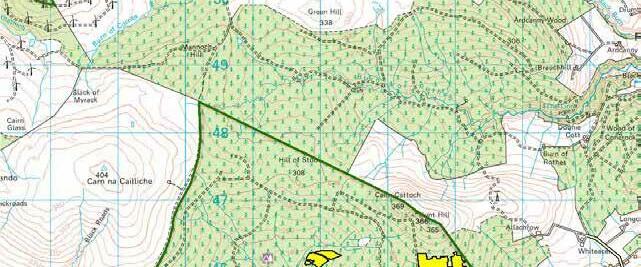
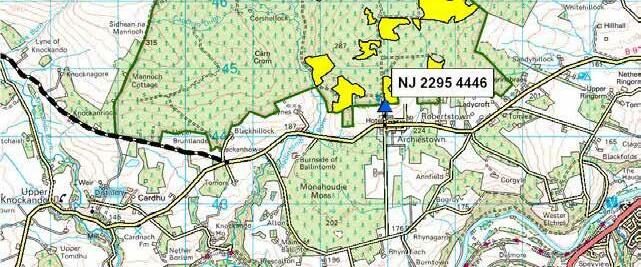

There are not many places where you can study forestry in the UK, but there are a variety of different ways that you can undertake your learning.

England
The University of Cumbria is home to the National School of Forestry, providing a range of courses at both Undergraduate and postgraduate level.
https://www.cumbria.ac.uk/study/academicdepartments/institute-of-science-andenvironment/the-national-school-of-forestry/
Scotland
The Scottish School of Forestry in Inverness is Scotland’s only forestry and arboriculture training provider delivering both further education and higher education programmes
within its own practical training environment. They run programmes for people new to the industry and those looking to upskill.
https://www.inverness.uhi.ac.uk/scottish-schoolof-forestry/
SRUC Barony Campus is set within a working 260 hectare estate, which is situated in the rolling landscape of Dumfries and Galloway in South West Scotland. Students here can undertake a variety of practical courses in forestry and arboriculture at further education level.
https://www.sruc.ac.uk/courses-training/subjectareas/forestry-arboriculture/
Wales
Bangor University in North Wales is the longest standing forestry department in the UK and has a wide range of course options available at all levels.
https://www.bangor.ac.uk/courses/ undergraduate/d500-forestry
There are several fantastic training providers and FFF (Focus on Forestry First) can support you in finding local training providers.
https://www.focusonforestryfirst.co.uk/
FISA (the Forest Industry Safety Accord) has a range of courses available for both Operators and Trainers, and you can view individual courses and make applications on-line. It is important to remember that in areas such as chainsaw work, you are required to undertake refresher training every 5 years. It is your responsibility to ensure you remain compliant. Occasional users of a chainsaw should consider
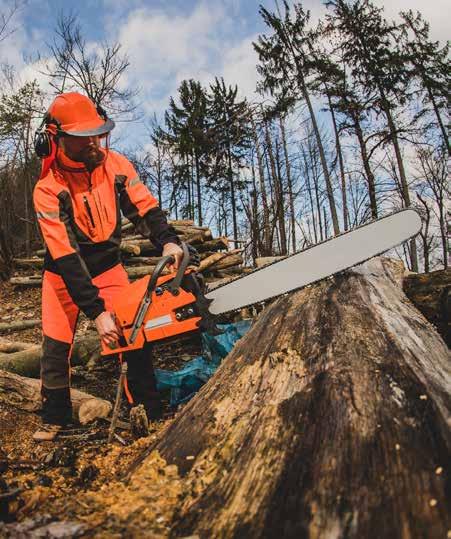
taking a refresher course more frequently, for example every 3 years. You can find out more here:
https://ukfisa.com/Training
You can visit the Lantra Awards website, for a list of courses available.
https://www.lantra.co.uk/forestry-arboriculture
And their website also has a search function that will allow you to search for a training provider in your local area.
The City and Guilds/NPTC website has Assessment Schedules and Workbooks that students can download to study and practice gathering information at no cost and has more information about competency assessments. https://www.nptc.org.uk/default.aspx
“The best time to plant a tree was twenty years ago. The second best time is now.” Chinese Proverb

Apprenticeships combine structured learning with on-the-job experience.
This lets people work, learn and earn at the same time. Employers can access Government support towards the costs of their training and assessments, through a training provider who works with the business.
In Scotland there are three training providers – The Scottish School of Forestry in Inverness, SRUC Barony in Dumfries (see previous section) and Rural Skills Scotland.
https://www.ruralskillsscotland.com/
In England, the main providers are Plumpton College, Lynher Training, the SMB Group and Herefordshire, Ludlow and North Shropshire College. For the most up to date list please visit this site: https://www.gov.uk/employers-findapprenticeship-training
Apprenticeships in Wales are supported by Careers Wales – They provide a search website for young people interested in doing an apprenticeship. https://careerswales.gov.wales/apprenticeshipsearch
And for a full list of training providers check out: https://gov.wales/apprenticeship-trainingproviders
In Scotland the most common type of apprenticeship is a Modern Apprenticeship. Scottish Modern Apprenticeships and Welsh Apprenticeships are a package of qualifications including a large qualification designed to test technical competence in the work place. In Scotland these are called Scottish Vocational Qualifications (SVQs). In Wales the titles vary, but an example might be a Diploma in Work Based Trees and Timber. Apprenticeships are quite different from how you might have studied before. Here are some terms that might be useful to know:
Candidate: The person who wants to achieve the apprenticeship
Assessor: The person who assesses the candidates and decides if they are competent. This may be someone in the business who is
a recognised assessor and has trained as one.
Or, it may be an external assessor appointed by the training provider. The Assessor will have experience in the area of work and is responsible for judging when the candidate is competent and will help them plan and organise their evidence.
Workplace Observer: During normal duties, candidates are continually being assessed by their Manager or Supervisor to ensure they are working to the correct standards, observing health and safety regulations and using appropriate techniques, materials, and equipment. These observations can be used as evidence towards the qualification.
Evidence is kept in a file, often called a portfolio. These documents help the candidate to collect, present and cross-reference the evidence to the national standards that are required to complete and achieve the award that they are studying for.
The main forms of evidence include:
• Observation – Performance at Work
• Questioning – Oral/Written
• Historical Evidence
• Handbook Referral
• Witness Testimony
A portfolio is also a means of recording and monitoring the assessment process, and it can tell an external verifier what stage a candidate has reached in achieving the qualification. Once the portfolio has been completed, the work is submitted for verification and if successful, a certificate issued.
In England apprenticeships are not structured around qualifications, although they may contain some under certain conditions. The apprenticeship certificate is considered equivalent to a qualification and has rigorous quality assured assessments similar to those for qualifications.
In England apprenticeships are tested at the end by someone independent of your employer and training provider. These end point assessments are sometimes compared to a driving test where the candidate should demonstrate they can put together their skills and knowledge and show they can do the job.
In Scotland and Wales you can tailor the skills to the job, but in England it is more ‘one size fits all’. This is where I spend the effort directing them to the different apprenticeships that might suit their needs e.g. a forest nursery might need to look at horticulture.
To get started read the Government guidance and talk to training providers (try and find more than one if you can).
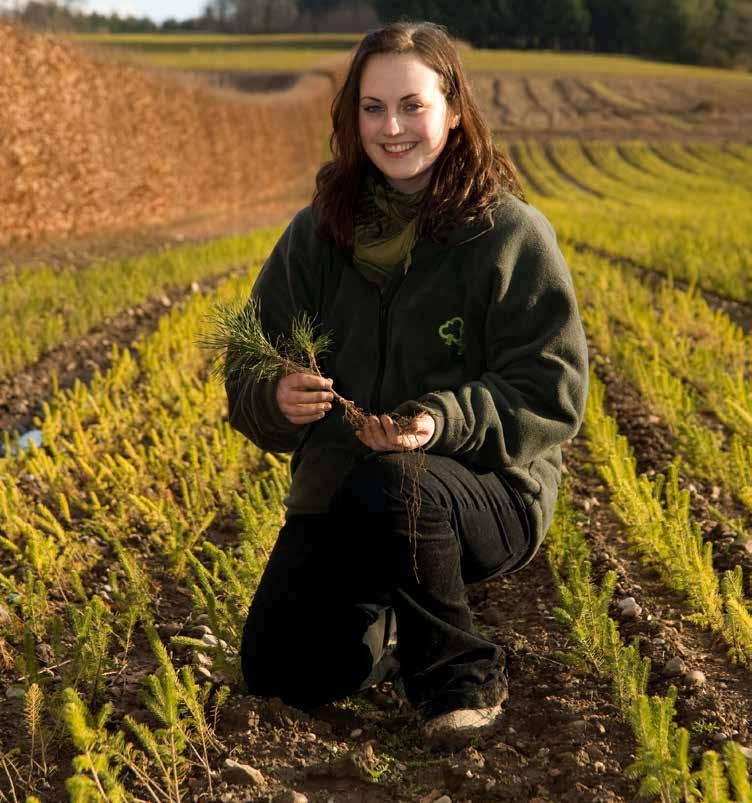
In Scotland, forestry and timber sector subjects are available across a wide range of qualifications from National Progression Awards to SVQs and Modern Apprenticeships. In England, from 2023, the current post-16 qualifications will be largely replaced by T Levels. The relevant one will be “Agriculture, Land Management and Production” with a specialism in tree and woodland management. You can also do apprenticeships. Wales is continuing with the current Level 2 and Level 3 vocational courses. At a higher level you can also do Foundation Degrees, Undergraduate or postgraduate studies in all three nations.
Check out some of the courses available here (ICF) and here from the Royal Scottish Forestry Society https://rfs.org.uk/learning/collegesand-universities/careers/what-types-ofcourses-could-i-do/
There are many other degrees that can lead to a career in forestry, such as Geography, Biology, Environmental Science. Many individuals move into forestry later in their careers, having taken a circuitous path to the sector. You may however find that you need to undertake some additional study if you wish to take up certain forestry roles.
There are different names for the qualification levels available in England, Wales and Northern Ireland. A full list of the levels available can be found here https://www.gov.uk/what-differentqualification-levels-mean/list-of-qualificationlevels. How these compare to those in Scotland is explained here Interactive Framework | Scottish Credit and Qualifications Framework (scqf.org.uk)
There are a wide variety of criteria that apply when determining whether your course will be funded or whether you will need to pay fees. The fee level will also be affected by your age, existing qualifications, residency and employment status. More details are available here https://www.gov.uk/further-educationcourses
The Open University has some free support to help you develop study skills https://help.open.ac.uk/browse/study-skills as do UCAS https://www.ucas.com/undergraduate/studentlife/study-skills-guides
ICF - The Institute of Chartered Foresters is the Royal Chartered body for foresters and arboriculturists in the UK. It is the only UK body to offer the Chartered Forester and Chartered Arboriculturist titles. https://www.charteredforesters.org/about-us/
Confor is a membership organisation for sustainable forestry and wood-using businesses. They provide a powerful voice to ensure our forest industries thrive long into the future. https://www.confor.org.uk/about-us/
The Royal Forestry Society - established over 135 years ago, the RFS is a membership organisation dedicated to sharing knowledge on the art and science of woodland management. https://rfs.org.uk/
Royal Scottish Forestry Society - exists to promote excellence of forestry in Scotland for the benefit of the present and future generations. They bring people together to improve knowledge an understanding of forestry with a strong emphasis on sharing practical experience. https://www.rsfs.org.uk/
Coed Cymru – Welsh Woodlands and Timber - aims to improve the landscapes of Wales that contain woodlands and trees. Their staff provide advice and support, access to innovation and grant aid. Contact them for information and support regarding any aspect of woodland creation, management and timber.
Natural Resources Wales actively encourages staff to use Welsh language and offers support to those interested in learning. This provides a fantastic opportunity both to help keep the Welsh language alive and help you to be able to conduct business in Welsh as you work within your community and with local farmers and landowners.
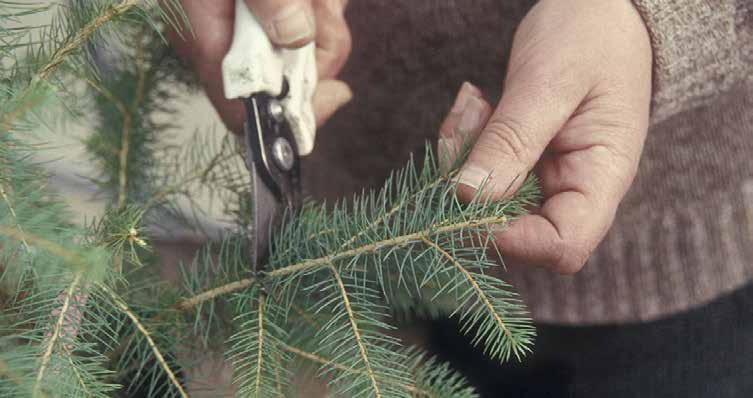
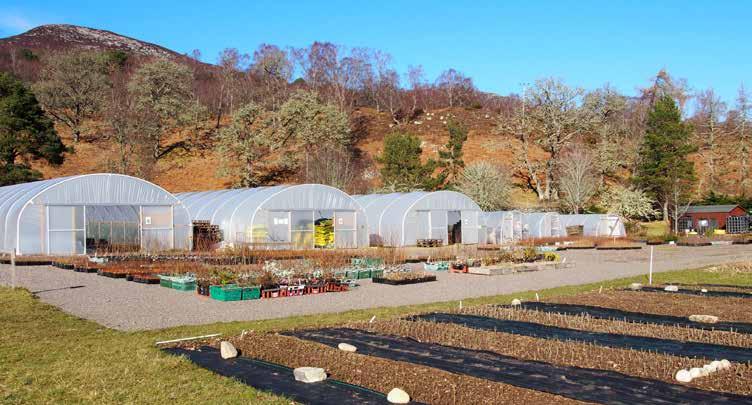
“Someone sitting in the shade today because someone planted a tree a long time ago.” Warren Buffett
Emma Staniforth, from Dalswinton near Dumfries, is not your typical forester. As one of the few women working in a male-dominated sector - only 24% of the total forestry workforce are female - she is already breaking the mould. At the age of 34 and having no prior experience, Emma was chosen out of 800 applicants to join Forest Enterprise Scotland’s highly sought-after Modern Apprenticeship programme.
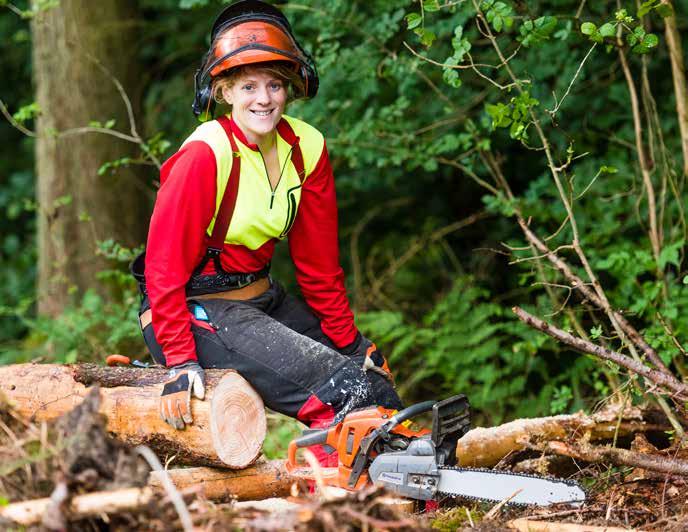
By combining practical, hands-on work experience and theoretical study, she realised that the Modern Apprenticeship would allow her to develop her interests, gain qualifications and lead to full-time employment in a land-based career.
Fast forward 15 months and Emma is now an integral part of a small team at Forest Enterprise Scotland, managing forestry in Dumfries and Galloway in southwest Scotland. She is working as a Forest Craftsperson supporting the Forest Management Department on all aspects of managing young tree plantations. This is a demanding, year-round role that includes winter tasks ranging from tree deliveries to artificial reforestation and restocking.
In the spring, Emma is involved in site surveys to establish the success of tree planting, as well as vegetation clearance using mechanical and chemical methods of control. Part of this involves repairing and constructing fencing to protect young trees from deer and sheep. In early summer, her attention shifts to tree felling and respacing operations using the skills she learnt on her chainsaw and clearing saw courses. She also gets involved in maintenance work with the recreation squad to improve tree safety around walks and facilities, as well as path construction and grass cutting.
“I take great pride in the positive impact my everyday role has on the environment and the wider public. I enjoy seeing the succession of the forest over time and the actual process and results of my work, from clearance to ground preparation, planting, looking after the trees and monitoring their health, beat up, tariffing, harvesting and back to ground preparation to start the process again. I like to think that the work I undertake from the micro up to the landscape level, is establishing woodlands for future generations and the forest industry.”
“I take great pride in the positive impact my everyday role has on the environment and the wider public.”
I am an environmental scientist interested in trees, wood and water. I’m researching how trees and wood in and around rivers influence water quality, and especially how we can restore and manage woodlands and waters to improve water quality and ecosystem health.

Rivers and streams can act like a liver, removing pollutants and cleaning up water as it flows downstream. However, centuries of mismanagement – like channelization, dredging and removal of riparian zones – has reduced this capacity, contributing to the poor state of our waters in England, where 0% of river, lakes and streams are classed as in good health. Introducing wood in rivers, directly in restoration or indirectly by re-wooding riparian zones, might offer a nature-based solution to polluted waters.
I am lucky to spend so much time outside in rivers and forests. I also spend lots of long nights in the lab analysing thousands of water and gas samples. Growing up in Yorkshire, almost all my daylight hours were spent outside. I still love being outside, especially in woods and forests where I feel most at peace.
Doing a PhD affords great freedom. It allows me to choose, to some extent, what I’m working on, to theorize and hypothesise, to investigate and experiment. It’s a thoughtful, creative process, involving teams of interesting, passionate people setting their minds to a single problem or question. Knowing I am contributing to work that is important and impactful makes the hard work worthwhile.
Before university I barely knew what a PhD was and when I learned about this academic pathway I assumed it was beyond my grasp. However, it was not as far off as I thought. Academic achievement is important but a track record of interest, initiative and self-motivation will identify you as a good candidate. Go to conferences (which are often free for students), get involved with volunteering and seek out opportunities for relevant experience. Whilst the application process can be competitive, there are more PhD projects advertised now than ever before.
I am fortunate to have easy-going supervisors who have allowed me to jump down rabbit holes and follow winding paths, but pulled me back on course when I have strayed slightly too far from the main goal. If you’re an inquisitive person, I’d say go for it!
“Growing up in Yorkshire, almost all my daylight hours were spent outside. I still love being outside, especially in woods and forests where I feel most at peace.”
Ben Howard, Doctoral Researcher at the University of Birmingham

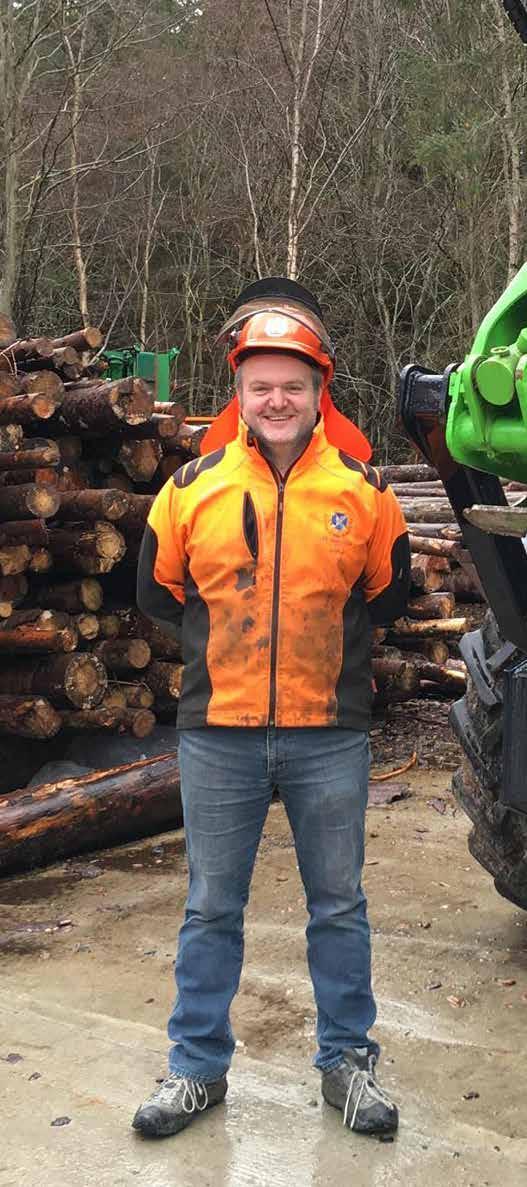

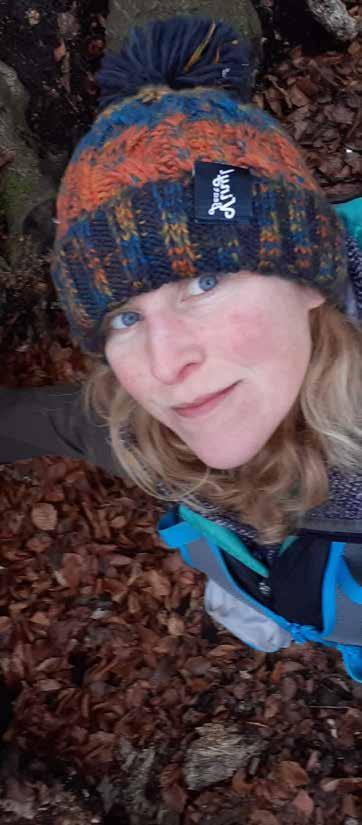
Operator,
at the
School of
always
work in conservation forestry.
Estate Manager for the
lead a team looking after
Taken from the Forestry Commission “Technical Glossary” A document defining some of the terms used in the 2011 Production Forecast technical documentation.
Area Forest and woodland area can be defined as net forest area – the land actually covered by trees (in the National Forest Inventory and Forecast System defined as to the drip line of the canopy); and gross forest area which includes both the area covered by trees and the open spaces (of less than 0.5 hectares) within the forest boundary (e.g. rides, glades, ponds).
Biological potential
The cross-sectional area of the stem of an individual tree at its breast height point. Alternatively, the sum of the basal areas of trees in an area of woodland.
The sum of the basal areas of trees in an area of woodland expressed on a per-hectare basis.
A term applied to forecast scenarios broadly consistent with the objective of maximising timber production. It typically involves felling stands in the year of maximum MAI and Management Table thinning. It may not take account of factors that constrain thinning and felling, such as wind risk and pest infestation. The main biological potential forecast referred to in the published forecast reports involves constraints on thinning and times of felling to take account of wind risk.
Cubic metre (m3)
All of the material making up a tree, or group of trees, or specified tree components such as stem or branches.
The woody material of trees excluding the stem, stump and roots.
The branches and associated foliage of a tree.
Unit of volume, usually used as the unit for measurements of tree stem volumes.
The cross-sectional area of the stem of an individual tree at its breast height point. Alternatively, the sum of the basal areas of trees in an area of woodland.
The cross-sectional area of the stem of an individual tree at its breast height point. Alternatively, the sum of the basal areas of trees in an area of woodland.
The diameter on the stem of a tree at ‘breast height’, i.e. 1.3 metres from ground level.
An index used in Britain of the potential productivity of even-aged stands of trees, based on assessment of stand age and top height.
A term broadly referring to the standing resource of living trees at a point in time.
Unit of area equivalent to 100 metres x 100 metres = 10,000 square metres. 1 ha = 2.47 acres.
The increase in volume of a tree or a stand over a year or annualized over a specified period measured either in m3 per year or in m3 per hectare per year. See mean annual increment (MAI).
The restocking of areas of felled trees with trees of the same species and yield class.
The majority of Forestry Commission yield tables (which effectively represent a set of benchmarks for forest management) prescribe a sequence of thinnings over the life of a forest stand. Management table thinning refers to the pattern of thinning recommended in these yield tables. In standard yield tables the thinnings are set to an intensity which aims to maximise diameter increment whilst also maintaining maximum cumulative volume production. See thinning intensity.
The maximum value of mean annual increment for a forest stand as observed directly or estimated from Forestry Commission yield tables. Under UK conditions, maximum MAI is usually achieved after a number of decades. See mean annual increment.
Mean annual increment is the average rate of volume production up to a given year, expressed in cubic metres per hectare per year. In even aged stands it is calculated by dividing cumulative volume production by age.
The dbh corresponding to the mean basal area of the trees in an area of woodland.
The study of the measurement of lengths, areas, volumes and related quantities. Forest Mensuration is concerned primarily with the measurement of trees, woods and forests including standing and felled timber.
The number of trees in an area of woodland expressed on a per-hectare basis.
Unit of mass. When applied to wood it represents the mass of wood in tonnes, not including the mass due to the water content of green wood (which may vary considerably).
Used as a qualification when the diameter or volume of wood includes the bark. See also underbark.
A subjective term used to describe a stand composed of: either trees whose continued growth is constrained by competition between their crowns. or trees whose stocking density is greater than a specified target level, for example as obtained from a standard yield table. or both of the above. See stocking density.
Restocking plan
A plan describing details of how felled areas are to be replanted or regenerated (for example choice of species and target plant spacing).
A distinct area of woodland, generally composed of a uniform group of trees in terms of species composition and the spatial distribution, age class distribution and size class distribution of the trees.
An assessment or estimate of the stem volume of a standing tree or group of standing trees. Stem volume is usually expressed in cubic metres overbark standing (m3 obs). In the production forecast, standing coniferous volume is defined as live coniferous stemwood (see separate definition). It excludes small branches, foliage and deadwood. In the published reports, standing volume estimates for private sector woodlands exclude woodlands of less than 0.5 hectare.
The woody material forming the above ground main growing shoot(s) of a tree or stand of trees. The stem is defined as including all woody volume above ground with a diameter greater than 7 cm over bark. Stemwood includes wood in major branches where there is at least 3m of ‘straight’ length to 7 cm top diameter. See stem.
Usually the number of trees in a given area. Usually expressed on a per hectare basis. Sometimes used to refer to basal area per hectare or volume per hectare.
A distinct parcel of land, distinguished from it’s neighbours through its overall land use, woodland composition etc. A sub-compartment may contain one or more sub-components.
Unique combination of stand description and intended management which is passed to the Forecast System for processing. See also component.
The top height of a stand at which wind damage is expected to reach a level necessitating clearfelling.
The periodic harvesting of trees in a woodland, involving the removal of some trees for commercial utilisation and the retention of others for future production or long term retention.
A measure of the ‘lightness’ or ‘heaviness’ of a thinning, generally expressed in terms of the amount of timber volume per hectare removed relative to the growth rate of a forest stand.
The diameter of the smaller (top) end of a length of stemwood, branchwood or log, often used to define different categories of wood products (e.g. sawlogs, roundwood, pulp) and merchantable timber.
The mean total height of the 100 largest trees in a hectare of woodland. Usually assessed on a sample of the largest trees in a series of circular plots of 0.01 ha in area.
The vertical distance from ground level to the uppermost part of the tree.
Used as a qualification when the diameter or volume of wood excludes the bark. See also overbark.
A subjective term used to describe a stand composed of: Either trees with significant (and by implication ‘unproductive’) open space between their crowns Or Trees whose stocking density is less than a specified target level, for example as obtained from a standard yield table Or both of the above. See stocking density.
The stem volume, expressed in cubic metres, to 7 cm top diameter over bark of an individual tree, group of trees or all the trees in a woodland.
The year or age at which a stand achieves, or is estimated to achieve, maximum MAI. Felling and re-establishing the stand at this age will achieve the highest average production per annum. See maximum MAI, mean annual increment.

An index used in the UK of the potential productivity of even-aged stands of trees based on maximum MAI. See maximum MAI.
The importance of skills development, education and training is recognised in ‘Roots For Further Growth, the Economic Strategy For Scotland’s Forest & Timber Technologies Sector’ - in which, ‘Developing a Workforce with Skills for the Future’ is a key strategic theme. Also in this recent FSF Report: https://www. lantra.co.uk/sites/default/ files/2021-08/Forestry%20 Workforce%20Research%20 Final%20Report%2013.08.21. pdf
The Forest and Timber Technologies Industry Skills Group – which is a working group of the Industry Leadership group – have created this induction pack to support the forestry workforce.
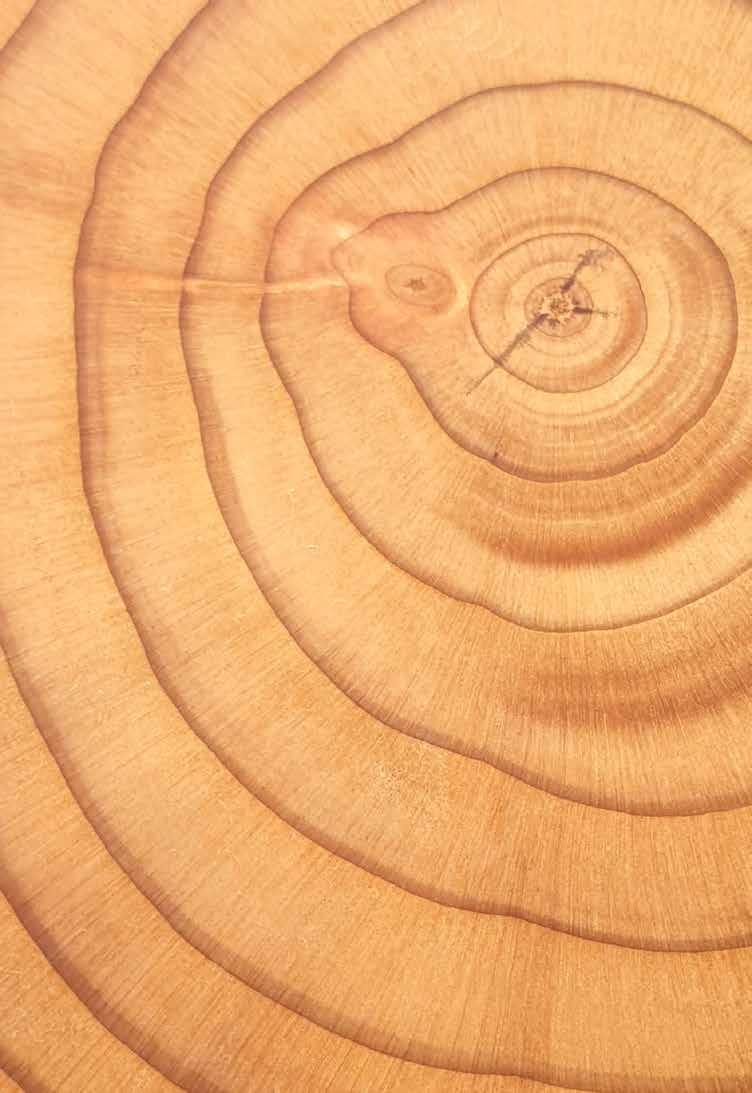
Lantra Scotland work to ensure those working in the land based and aquaculture sectors can get the training, qualifications and skills they need to succeed.

Their website includes a range of information from career opportunities to training courses.


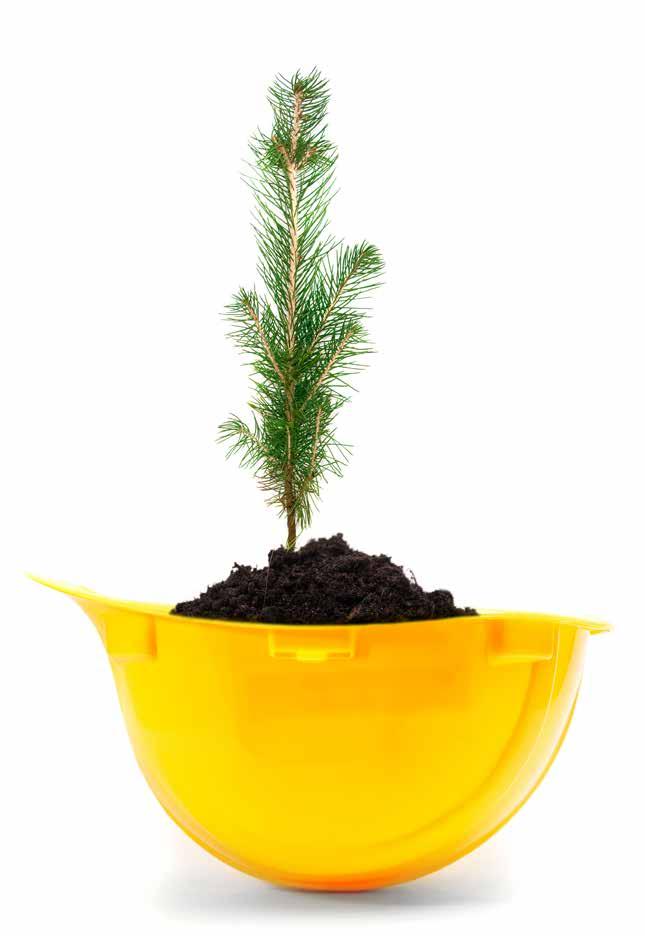
Read their latest newsletter, subscribe to it or contact them at: scotland@lantra.co.uk
This document was
